
 Mouth of The River
Publication of Oyster River High School
Mouth of The River
Publication of Oyster River High School


 Mouth of The River
Publication of Oyster River High School
Mouth of The River
Publication of Oyster River High School
New Faces...03
Meet the Staff...04
Petter Sandvik...06
Funk Music...08

Freedom Cafe...10 Bobcat Corner...12
Mendums Pond...13 Cowell Stadium...14 Changes at ORHS..16
SPORTS/CLUBS - S
Managing Budget...18 Transgender Rights...20 Lack of Sleep...21
“The Barrington Kid”...23
The Cost of Your Future..24 Creativity & School...26 Education...28
Why You Should Care...29 A Greener Bobcat... 32
Pre-season... 34 Girls Soccer Coach...35 Fieldhockey: Title IX...36

This fall, we, the Mouth of the River staff, are excited to present you with the first issue of our quarterly circuit. Continuing from last year’s changes, we will provide our readers with both a visually appealing and informative news magazine. We now have an almost entirely new staff that has presented the magazine with many fresh ideas and perspectives.

This year Mouth of the River will continue with our magazine-style format, while increasing our focus on the presentation of the magazine. Building off of the ideals formulated during Mouth of the River’s transition from a newspaper to a magazine this past year, each issue will be just as engaging to the eye as it is informative. You will see the publication take on an elegant and minimalist air that leaves no room for clutter. Just as quality literature is essential, so is its presentation.
This year, the staff has two co-editor in chiefs. With only three returning members to the staff, we have a core leadership group. In this issue our staff chose topics that are relevant to both com munity members and non community members. As the year progresses we hope to continue to improve, so as always your feedback is greatly appreciated. We hope you enjoy the first issue and look forward to the issues to come!
Isabelle Todd and Conrad Dundorf
Editors in Chief

MouthoftheRiverseekstoreliablyinformthestudentbody,aswellasthesurrounding community,ofinterestingandnewsworthycontentinamodern,compellingformat. OurgoalasastaffistogiveavoicetothestudentsofOysterRiver,andhaveitheardby anyandallofourreaders.
Find us at
Twitter: @MORnewspaper Email: mornewspaper@gmail.com Website: mornewspaper.com
I’m sure that as you have walked around this quarter you have seen some unfamiliar facility members. Three new teachers have joined the Oyster River staff this school year. MOR dug into how and why they became teachers.
Shay Willard began working as the video production teacher at the start of this year, replacing Kathleen Young who retired. Willard has taught high school aged students to not only use a camera, but to create movies for ten years. Having taught at various film camps for years, he decided that he want to teach and “help usher in the new generation of artists.” Willard has mod eled some of the assignments in his class after various real world experiences, such as working as an assistant on Metro Station music videos, and an editor on Rescue Renovation.
“His experience in the professional world allows him to bring more to his students, and really enriches their learning,” said Meredith Freeman-Caple, a performance art teacher who has worked with Willard for years.
“Willard is very hands on and always there to help,” said Video Pro duction student Gabe Hertz-Kahn (‘18)
Willard is excited that his students will be able to create their own original content; in the past his students typically have just created videos from a prewritten script.
“I want the students to come out of this class being able to tell three act stories through a visual medium,” said Willard. “I’m very excited to be here.”
Adam Lacasse began working as a business teacher alongside Heather Healy in the newly formatted business department at the beginning of this year. Af ter spending 15 years working at music venues such as the Casino Ballroom and the House of Blues, he came to Oyster River seeking a better work and life balance.

“[A] benefit of coming here is that I can help formalize the business program [at Oyster River], and create some formal curriculum that will give some career paths to students into the business world,” said Lacasse. In the coming years Lacasse plans to create a business department, with various classes focused on different aspects.
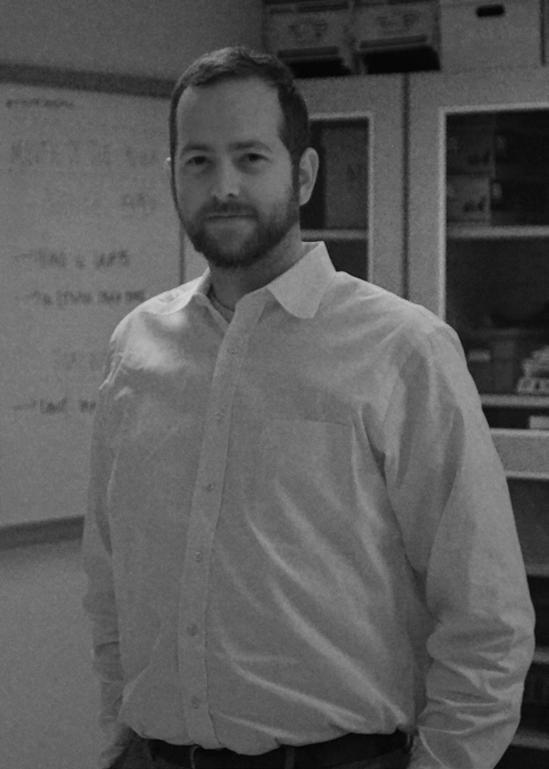
“He's doing an excellent job with his classes, especially since the class has nev er been done before so he has to come up with curriculum,” says Kevin Kerrig an (‘16) on Lacasse’s new class, Marketing.
In the coming years Lacasse will refine the teaching of his class, and wants to “[Bring] it all back, so that people can apply it,”.
FormoreinfoseeLizPaquette’sarticleonLacasse’sMarketingclass
Emily Rodgers, an Oyster River alumni, began working this year as a new physical ed ucator. She replaced Amy Mcphee, who retired last year. Rodgers knew she wanted to be a physical educator after seeing the camaraderie between P.E. teachers when she was in school. “I knew I didn't want to sit behind a desk all my life,” said Rodgers. Being a P.E. teacher gives her a unique opportunity to “give students the tools they need to succeed over a lifetime,”.
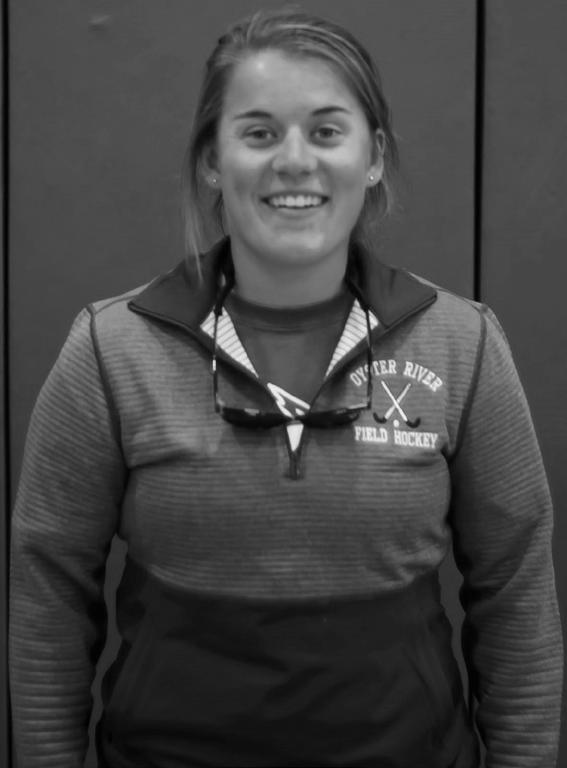
Rodgers came back to this school in particular because during her interview pro cess someone told her that “What you really should do is go back from where you came from and change that school and make it better; Learn from when you were a student,” remembers Rodgers.
“I think since she went to Oyster River she really knows how to run this and that's really helpful. She can also sees from a student's perspective,” said sophomore Maisie Cook. Inaddition, Rodgers is bringing various new things to the P.E. department such as adven ture education unit, and a new perspective.
“She's just a breath of fresh air...she’s really bringing new ideas that are improving the program,” said Don Maynard, a fellow P.E. teacher.
In the coming years Rodgers hopes to expand the P.E. program to include new units and help coach the girls lacrosse program here.
-Dillon Mulhern
Lydia Concannon (‘17) is the News Editor. She enjoys Seacoast Swimming after school, the high school swim team, skiing, and doing hurdles during spring track. She was interested in be coming part of the MOR because she “thought this class would be interesting, [she] likes the style of writing in journalism and finding out stories and talking to people.” One time she was tricked into eating fried crickets, and that was the strangest thing she’s ever consumed.



Andrea Staples (‘17) is the Busi ness Manager. She plays volley ball, and volunteers at St. Anne’s Nursing Home in Dover. “I’ve never really been a huge fan of English, but then I took Journal ism One and I really liked it, and I wanted to continue learning and practicing my skills.” One of her weirdest habits is that every thing has to be extremely orga nized or it frustrates her.

Liz Paquette (‘16) is the Website Manager. She is the co-captain of the varsity volleyball team, and is involved in Relay for Life and NHS. She also enjoys kayaking and playing video games in her free time. “I joined MOR because I love delivering facts about hot topics to the public. I like to keep people informed and I also en joy learning about these stories as well.” If she could go back in time she would like to see the 1950’s.

Katie Schmitt (‘17) is the circu lation manager for MOR. is en gaged in the sustainability club and is a class representative. She is also on the cross country team and enjoys running. She was interested in MOR because “it’s neat to cover stories that I think are relevant or interesting and be able to put my opinion in it.” The weirdest thing she’s ever eaten was a barbeque flavored cricket.
Owen Kurtiak (‘17) is the Sports Editor. He is on the varsity soccer team, and runs indoor and out door track and plays offseason soccer. “I really enjoyed Journal ism One, and I like how Mouth of the River is more business like and more serious.” The strang est thing he’s ever eaten was dog food on a dare.
Betsy Larson (‘17) is the Social Media Manager. She is on the cross country and track teams, and she loves hiking, waterski ing, and swimming. “I thought that news and figuring out infor mation was really cool and I like giving straight facts and having the reader interpret them from their own perspective.” Her fa vorite words are any words that have a z in them and tortellini, and her least favorite word is swallow.



Jake Garner (’16) is the Op-Ed Editor, and this is his second year on MOR. He enjoys skiing and being with friends, and loves the mountains and the outdoors. He is excited to graduate early to go to spend a month in New Zealand then study communi cations at college in the fall. “I like the voice of journalism, I like the way it writes and I like in forming people about important topics in the community.” The strangest thing he’s ever eaten is cow tongue, which “tastes kind of like hot dog.”.


Jessie Stelter (‘16) is the Layout Editor and is co-captain of the varsity field hockey team and is on varsity tennis. She enjoys skiing and she loves to draw. “[Journalism] has taught me how to write well and I have always wanted to educate people about important stories.”She loves to travel and hopes to study abroad in college.


Dillon Mulhern (’17) is part of the cross country team, indoor and outdoor track and enjoys hanging out with his friends. He chose to participate in MOR be cause “Journalism One was a re ally fun experience, and I really like the writing style of journal ism and you can research things you like.” The longest he’s ever gone without sleep was 48 hours.
Isabelle Todd (‘16) is the Features Co-Editor and a Co-Editor-in-Chief and this is her second year on MOR. She is the co-captain of the varsity Soccer team, and she also runs in door and outdoor track. “I really like how it’s more of a job than a class. I learned a lot last year and I’m learn ing a lot this year. It’s a great real world experience. You end up with a really cool product that the entire community reads.” Her weirdest habit is constantly using the same four negative descriptive words: vile, foul, putrid, and wretched.

Conrad Dundorf (‘16) is one of the Features Editors and a CoEditor-in-Chief and this is his second year in MOR. He enjoys filmmaking, playing the violin and cello, and photography. “I came back because I love the staff and I love working with them. I like telling stories and there’s a lot of stories to tell.” If he could personally witness anything, it would be the moon landing.
Neville Caulfield (‘16) is the Pho to Editor for MOR. He has been on the cross country team for four years and is now a co-cap tain. He also participates in in door track and outdoor track, and he enjoys taking pictures and drawing. “After Journalism One, I was interested in getting experience in the real world and educating myself and also us ing my camera and my words to bring the story to other people and that’s why I joined MOR.”
If he could go back in time he would like to see huge dino saurs, and his weirdest quirk is that when he turns on shower, he goes up against the edge of the shower on his toes and waits for the water to warm up.
“I think he’s adjusting really well. He fits right in at school and especially with the team. He gets involved with team activities and he’s always looking to have a good time. He’s a great asset to the school and the team,” says Matt Silverman (‘16) varsity soccer player.
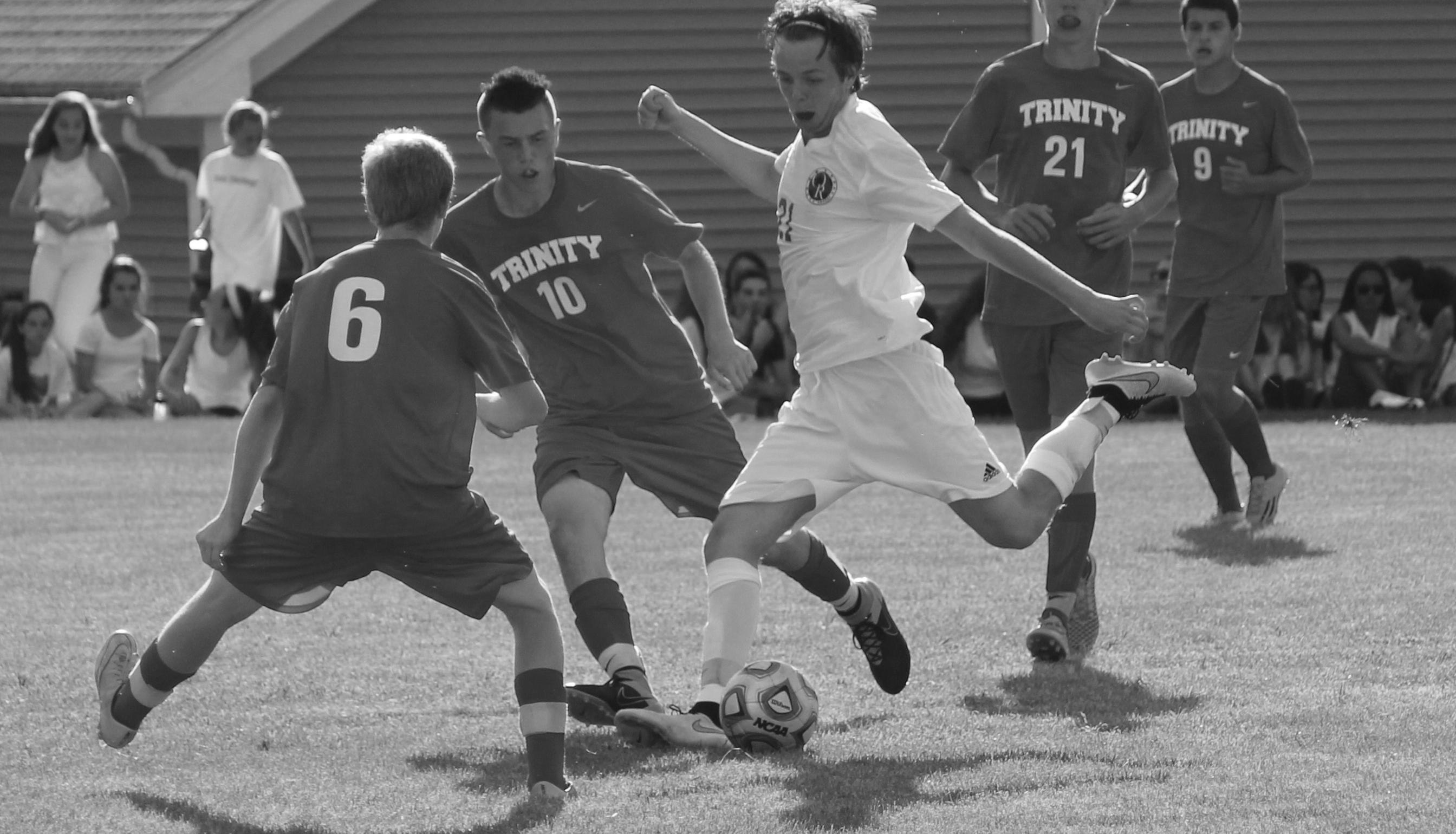
Petter Monsrud Sandvik, 17-years-old, travelled from Norway to America last August to meet his new family for the 2015-2016 school year at Oyster River High School: the Carpenters. His passion for travel as well as the in fluence of his siblings partaking in exchange programs encouraged him to spend a year of school in America, particularly Durham. He has quickly been adapting to the change in culture and schooling, but nonetheless has grown a part of the Carpenter’s family as well as a val ued player for the boys’ varsity soccer team.
Sandvik has played soccer since he was five-years-old. He began as a striker, but currently plays midfield. He also starts for the varsity team. “He is for sure one of our key players on the field. From his work rate to his skill [Petter] is just fantastic. Without him on the team it would be difficult because of his size; he helps win a lot of balls in the air and our midfield wouldn’t be as strong,” says Griffin Luczek (‘16) ORHS varsity soccer player.
Sandvik states that the coaching in Norway versus in America is very similar, but on occasion he has trouble understanding other players on the field. “It’s not so much big difference it’s like we don’t have soccer on the
high school team, we don’t do high school sports so I’m not used to training so much, so high school sports is a lot different.” Nonetheless, Sandvik seems to have fit right in, “Everyone [on the soccer team] is like your fam ily.”
The soccer team isn’t Petter’s only family in Durham; he has also grown very close with his host family: the Carpenters. “He’s always a really happy person; I know whenever I’m sad or down he can tell. He reads people really well and he can tell when I’m not having a good day. He’ll come up to me and do his best to make me feel better and make me happy; he can always get me to smile or laugh whenever,” says Sierra Carpenter (‘17). Both children in the Carpenter family play soccer, which increased the immediate bond that was made with Sand vik, “I think that we are almost like brothers in the sense of how close we are; he’s really fitting in,” says Max Car penter (‘19).
“It’s a nice family [the Carpenters] I love them; they are welcoming,” says Sandvik. The Carpenters have planned vacations this upcoming year for him to get many op portunities to travel, including a skiing trip to Canada. “I want to see more of America I think, big states like Washington or Florida or something, that would be so cool,” says Sandvik.
The Carpenters have a lot planned with Sandvik, firstly, they want him to see all aspects of their family. “ It’s
really important to us that he lives with us just like our own children. This means we don’t hide any thing...even the occasional bad stuff. He sees that we can have disagreements and run out of milk in the morning just like any other family. But he’ll get the good stuff too and share in the excitement or pride when something good happens to any of us,” says Kristin Carpenter. They also are hoping to plan to visit many places such as Boston, NYC, Washing ton DC, and maybe Florida. Max Carpenter hopes that him and Sandvik will be able to go ice climb ing/winter hiking together.
The Carpenters had been preparing to host an ex change student for 10 years, after their father, Kevan Carpenter, had hosted one from Sweden when he was a child. “We always knew we wanted to host because Kevan’s family hosted a boy from Sweden 35 years ago. We started the paperwork about a year ago and learned that Petter would be coming to us last March or April,” says Carpenter.
Sandvik travelled through a company called AFS. “I wrote something about myself: what I like to do, who I am, and then they put me on the site and people can go to that site and pick the student. The Carpenters picked me, so I didn’t know in America where I was supposed to go before like, I think two months before I went.” Carpenter further noted that they had, “literally picked Petter from a pile of ap plications,” and that they had picked him because of his love of the ocean, travel, soccer, and that he was continuously described as friendly and happy kid.
Despite the cultural differences between Norway and America, the biggest struggle for Sandvik has been the change in schooling. “I would say like the American school is a little bit more boring.” Ac cording to”The World’s Best 20 Education Systems” Norway is ranked #13 while America is ranked as #18. “I didn’t do as much homework in Norway;
teachers in Norway wanted us to do some home work [around 30 minutes to 1 hour], but they didn’t check if I did my homework. I don’t understand why homework is important because we are in school for eight hours a day and then we need to go home and do more work,” states Sandvik. He also states that the only class that he takes here that he wouldn’t be able to take in Norway is 3D Art. “It’s [school] very different because here you have the same schedule every day; in Norway you spread out in a week; for example Thursday and Wednesday we have French, but then we don’t have French Monday and Friday, so they spread your schedule out so that it’s a differ ent day every day.”
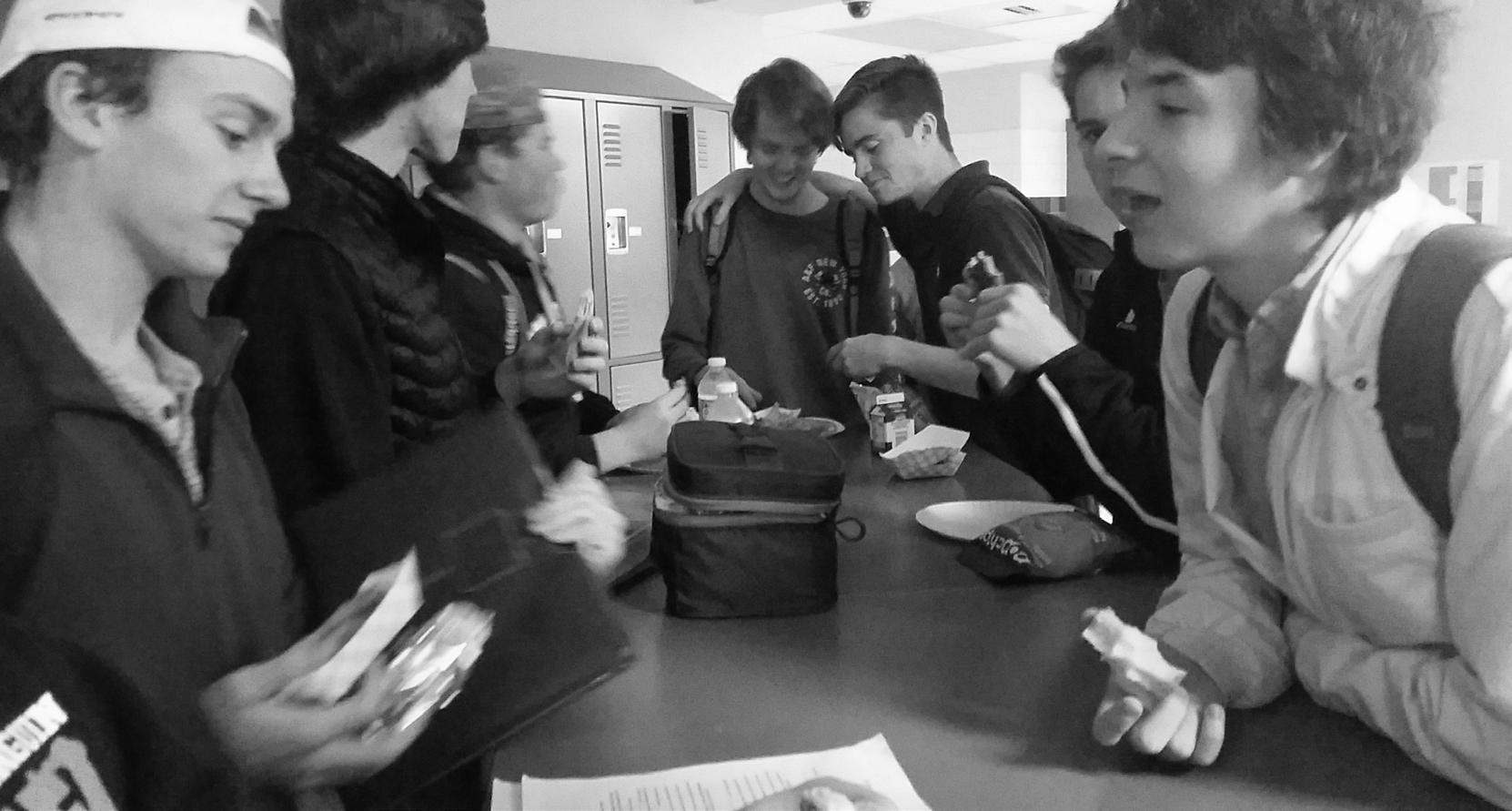
Sandvik is currently taking French at ORHS, but knows how to speak Norwegian and English. He began learning English when he was eleven, and states that it’ “getting easier and easier.” In Norway, he is also learning how to speak New Norwegian. He understands English very well, but still strug gles sometimes during soccer. “When people on the field ask me to do stuff sometimes I don’t under stand what they are saying so sometimes I do wrong stuff; that’s the hard part: just communication.”
Sandvik misses his family and friends the most “I shouldn’t be talking too much with people back home because that makes me more homesick, so I try to not talk to them so much.” When he returns to Norway, he will have one more year of schooling to complete. “I just want to travel; after school I am just going to take some years free just to travel.”
The Carpenters have accepted Sandvik as a mem ber of their own family, hopefully helping him with missing his family in Norway. “I know I speak for my whole family when I say how lucky we feel to have a new person to love. With him, Petter brings a piece of the world and a really important cultural perspective for us all to learn from,” says Carpenter.
-Andrea Staples Business Manager
“Petter brings a piece of the world and a really important cultural perspective for us all to learn from,”
Sandvik hanging out with friends in the Senior Core
Funk is undeniable and indescribable at the same time - it’s when a song or a sound rips you out of your chair so fast it leaves your pants in a smoldering pile on the floor,” said Max Harris, Keyboardist of Durham own Harsh Armadillo.

Funk is music that just hits you and before you know it you’re grooving and moving, and making an utter fool of your self. Tom Serner, the lead singer of swedish discofunk band Man ganas Garden defined it as “A style of music defined by what you leave out, thus letting the stripped essentials tease the listener into a groove.”
Harris defined funk as “the feeling of a party all around you,” Though funk is sometimes seen as a music of the past, I thoroughly believe that funk is the future of music as we know it. Funk music nowadays is not found in its purest form, instead elements of it are taken and to be meshed into a song.
Funk first came to rise in the 1970’s in the wake of psychedelic rock star Jimi Hendrix and soul artist James Brown. The new found genre brought together elements of these artist and others and cre ated something completely different.
“I find that older funk songs are more popular around the school, and I don’t really know many newer funk artists,” said Sara Di harce (‘18).
In more recent years OutKast and Gnarls Barkley really brought back more true funk back into the mainstream. “SpottieOttieDo paliscious, and Hey Ya [OutKast] are, in my opinion, some of funky grooves I’ve ever heard. I think that OutKast did an excellent job making funk more accessible for average people,” said Peter Ack erman, a freshman at University of Vermont.
“Funk music can be found all over modern music - in Pop, Rap, EDM and beyond. ‘Uptown Funk’ by Bruno Mars and Mark Ron son is the most obvious example but if you dig into the pieces that make up a lot of the songs you hear on the radio today, there is funk buried in the core somewhere. Whether it is a bass line or a funky guitar riff, or just a well timed grunt in the microphone (a la James Brown), it’s tough to miss some aspect of funk if you dig deep enough,” said Harris.
Though a lot of songs feature a funk influence, lots of students at ORHS struggle to identify quite what funk is: “I mean I know what it is, I just don’t really know how to describe what it is ,” said Kenzie Clark (‘17).
Most funk artist are not in mainstream, such as Manganas Gar den, Toro y Moi, Tuxedo, BoomBox, The Cat Empire, and Harsh Armadillo. But when the funk revolution does come, they will be ready.
“With funk you really cook your grooves,” said Serner. Most funk artist and bands spend years experimenting with fusing different styles to create the perfect groove.
In Manganas Garden, each of the members possessed a different musical style they liked and wanted to infuse into the final prod uct: “Everyone likes many different genres so it’s just a mash up, cause it’s like a very democratic writing procedure,” said Serner.
“Manganas Garden posing during a recent photo shoot Picture Credit: Manganas Garden
“With funk you really cook your grooves,” said Serner.Dillon Mulhern
Harsh Armadillo a band that was “conceived in a pool of gasoline at 3am in Durham on a stormy April day in 2013,” also exemplifies funk, in the sense that its sound is really created through a mashup of people who come from different musical backgrounds including a drummer who “practiced with a rabid racoon behind his kit for the first few weeks to ensure a properly harsh backbeat” explained Harris. In both of these groups rock, reggae, disco, soul and jazz fuse together to create a real powerhouse of a genre.

Unlike Electronic Dance Music, which features mostly comput er-generated sounds and beats, Funk is created from the soul using guitars, synths, pianos, horns, drums, and heck even cowbells. This distinction makes a world of difference during live shows. Having gone to both Funk and Electronic shows, I can say generally that with EDM the songs sound almost exactly like they do on your ipod. But with live bands, especially funk shows, the musicians put their soul into the music, and trust me the crowd can tell. People let loose with dance moves that they usually reserve for far more private events, and stuff gets heck of a lot more rowdy. “Gotta take the dance scene back to live bands. It’s always fun when you play live cause people dance and move and have a good time,” said Serner.
Though funk music isn’t the most well recognized genre Student Committee on Popular Entertainment at UNH releases a survey to identify artist and genre that the student body find most favorable. “Every year, we find that country, rap, and edm are the most request ed genres,” said a SCOPE representative. The survey also finds an insignificant amount of students request funk. Though it may not be popular at UNH, at the neighboring University of Vermont it is much more popular.
“Funk music is much better music to lay back and listen to,” said UVM freshman Jon Kilian. “Over at Higher Grounds [a venue close to UVM] it’s more typical for a funk artist to sell out than any other,”. Having been to UVM and Burlington myself you’re more likely to hear Groovy funk jams blasting from dorm and restaurant speakers alike.

“Gotta take the dance scene back to live bands. It’s always fun when you play live cause people dance and move and have a good time,” said Serner.Harsh Armadillo play at Scorps Bar and Grill Picture Credit: Harsh Armadillo Picture Credit: Harsh Armidillo
“The biggest thing we can ask of the com munity is just to come into the Café. We have a whole host of events and the best coffee and tea in town.” says Michael D’Angelo, chair director of the Freedom Cafe. D’Angelo was involved while attending University of New Hampshire and has continued to hold the po sition of chair director.
There are some things that are said, report ed, relayed or shown in the news, on the ra dio, that are disregarded, intentionally or not. For example, the global refugee crisis. This issue is presented on all major news corpo rations all around the world, yet... the crisis begins to grow. Yes people feel sympathetic, although do not take it as their duty to act as
an individual. Everyone nowadays seems to be too preoccupied by their own daily issues. There are some who use that information as an incentive to take action.
The Freedom Cafe, located in Durham, New Hampshire, opened in 2012 as a non-profit cafe dedicated to ending human trafficking and commercial exploitation of people. We always hear about the prominent issue of drug trafficking and how there are so many redundant efforts to eliminate this type of is sue. Although considering human trafficking is the second largest source of illegal income following drug trafficking and we rarely are informed of this issue... something needs to change.

“Hearing that human trafficking is happening more than it’s ever happened before, made me want to help out in any way I could.” says volunteer Isis Chapman, who began working with the Freedom Cafe after attending one of their open-mic nights. The open-mic nights are one of the Freedom Cafe’s many ways of obtaining money for the cause.
The Freedom cafe is not only reputable for its aspiration to raise funds for human trafficking, they are a non-profit organization. They encourage all members of the community to enjoy a cup of tea, coffee or hot cocoa in return for a suggested donation for their beverage, or becoming well educated about information pertaining to human trafficking. The cafe then promotes those to share their new acclaimed information with the community. The Freedom Cafe takes a new approach on a “welcoming atmosphere” in which there is no “up-front” cost for your beverage, although they provide you with an amount for a suggested donation.
“The idea for the Freedom Café began to develop following a trip to Nepal where I had the opportunity to be a part of a team serving survivors of bonded slavery. During the process of raising funds and participat ing in the project we discovered that hu man trafficking is a huge issue in our world that is extremely under resourced and un derfunded. And at the same time we dis covered how much the Durham and UNH community wants to be a part of bringing beneficial change into the world. The truth is that many times as people, we are affect ed by an issue, but don’t know what to do about it, so we wanted to create a simple pathway for people to get involved.” states Bryan Bessette, president and program di rector of the Freedom Cafe.
Human trafficking is classified and execut ed in many different ways, but it all comes down to the trading and purchasing of hu man entities for the benefit of whoever is au
thorizing the trade. In most circumstances, it will be young, vulnerable woman or chil dren who are targeted, as well as those who do not receive a significant income, who are forced into working in factories and fields with insubstantial conditions in return for shelter.
Under some circumstances insufficient food is given in return for the labor per formed, and in dubious situations, work is performed in hope of being rescued.
Considering that Human trafficking is such a prominent issue in the world, and people are so unaware of the significance of eliminating human trafficking, the mem bers of the cafe wanted to use this as an opportunity to inform the community in a collaborative way.
The Freedom cafe is affiliated with largescale organizations that have been involved in ending human-trafficking on a large scale basis.
“Stop the Traffik and the UN.GIFT project are just two stand-up organizations. We’ve been lucky to have met charismatic and interesting people in both organizations whom we have worked with. We believe both of these organizations have very similar values to us, as well.” stated D’Angelo. Both Stop the Traffic and UN.GIFT projects have taken the same incentive as the cafe concerning human trafficking. The UN.GIFT, United Nations Global Initiative to fight Human Trafficking have taken a unique approach to end human trafficking. The UN.GIFT organization, affiliated with the Freedom Cafe has set up tangeble observatories distributed throughout the United States, as well as various other Countries. The observatories consist of a display of photographs relaying the realistic, yet horrific situations. The Freedom Cafe manages of the gift box for the New England region.
Being involved in making a difference does not have to involve the commencement of a whole new orga nization, it can mean integrating yourself into an organization that has already begun, such as volunteering at the Freedom Cafe.
“Start off by just going into the cafe, reading some of the stories on the walls and asking questions. If you ask the barista how you can help, there will give you some ideas including buying only fair trade products, spreading awareness through social media, signing some petitions, volunteering at some events the cafe has, and just supporting the cafe,” Chapman says.
Those who are affiliated with the Freedom cafe don’t necessarily know everything regarding the subject of human trafficking. The main incentive at this point is to educate the community and enhance awareness.
“The more people who come in, the more of an impact we can have. And we are always looking for more volunteers. It’s our philosophy that even small amounts of volunteer time can make a huge difference, and we want to use volunteers in ways that meet their interests and talents.” says D’Angelo.
-Katie Schmitt Circulation ManagerIf you were to walk by what used to be Corey Parker, the athletic director’s former office in the morning, you’d probably wonder what’s ‘coming soon’ according to the sign on the door.
Students will have access to the new school store, The Bobcat Corner, at the end of November. The store is being created by the brand new Merchandising and Marketing class taught by new teacher Adam Lacasse. The store will sell branded spirit items, clothing, snacks and drinks.
Parker explains that “[the school store] naturally happened.” Over the summer, instead of working in his own office, he would work out of the former sub coordinator Bob Heuchling’s office because it was air conditioned and his was not. Then Heu chling retired, and it was decided that Parker would move into the office permanently. There was talk of using Parker’s old of fice space as a school store since now they had a place for it. “And then ironically, while looking back and talking to some veteran staff members, we learned that when the building was rebuilt 12 years ago, [my office] was initially intended to be a school store at the time. So they had plans for it, but they fizzled out, and now we’re excited to bring it back,” Parker ex plained.
Assistant Principal Mark Milliken was also very involved in the creation of the store. “We wanted to expand pathways for students, and [mar keting] was one that didn’t exist in the business area, so we wanted to create a new class that might interest kids,” he ex plained. “I love when you can do something in school that’s in real life, and what better way than if you’re doing marketing and business to have a business, that also contributes to your school.”
Mike McCann, assistant principal said “this is an opportunity for all students to engage in running the store, but it’s also a place for students to buy apparel and school supplies and it’s all right there.” McCann is excited about opening the store and also looking forward to spreading school spirit.
This year, the administration is working on rebranding the school, and pushing the concept of school spirit, or ‘Bobcat Pride.’ Parker explains that “[we want to] have more people come to sporting events and plays, and want to wear ORHS ap parel because it really carries over to the community. Hopefully in the coming months we will see people with bumper stickers, and parents wearing shirts and sweatshirts to school and dif ferent games and more.”
The administration needed people to run the store. They tied the brand new marketing class with the task of creating the store once they hired Adam Lacasse to teach the class. Lacasse is now a part time teacher at ORHS. He has over 15 years of ex perience in entertainment, working at places such as the House of Blues in Boston, MA and the Casino Ballroom in Hampton, NH.
“This class puts a real world perspective on something doable, and whether we fail or win there’s lessons to be learned, and it seems like everyone is pretty engaged and interested in [the store] which is cool,” he explained. “Every school has an area for students to buy things, and I think it promotes school spirit. It’d be cool to have a central area which promotes the school itself, and for people like me who forget pens and stuff, it’s al
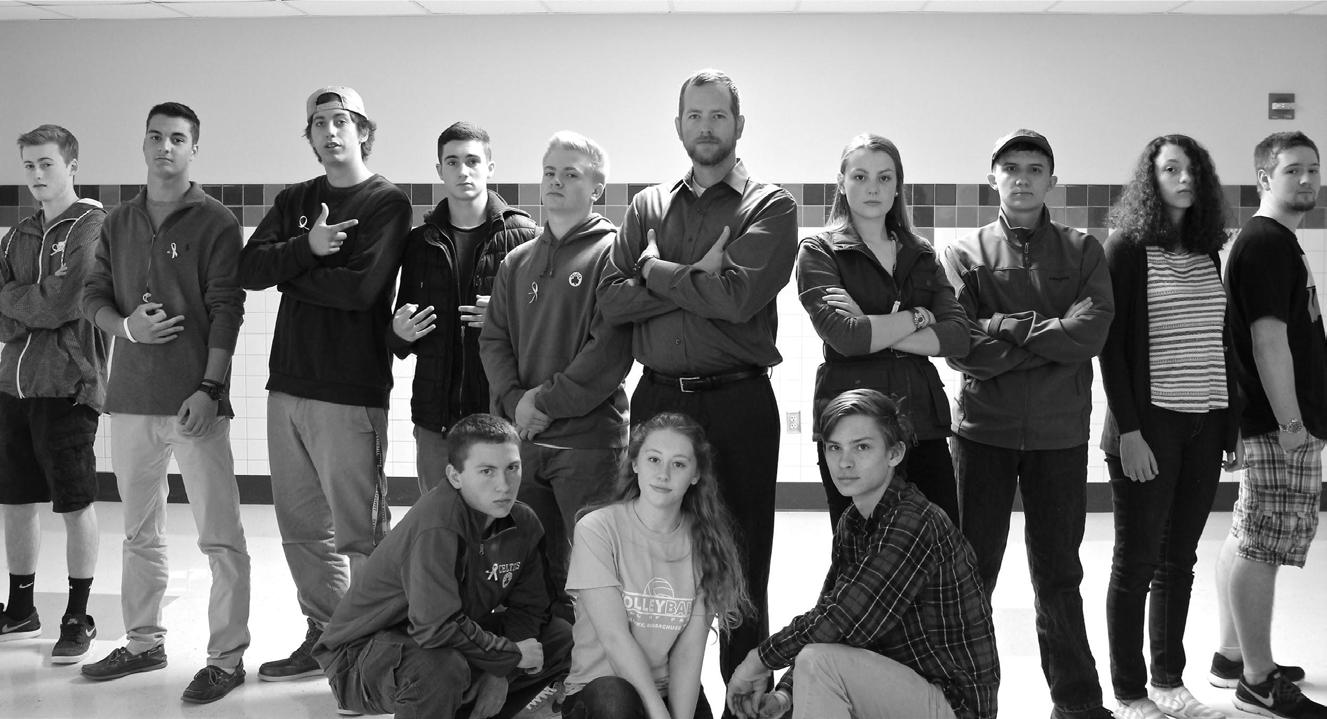
ways good to have a go to.”
The second the administrators met Lacasse, they knew he’d be perfect for the job. “Mr Lacasse’s experience working in busi ness and his approach was very professional,” explained Mil liken. “It’s low key and he’s interested in new ideas.” Lacasse was asked during the interview how he felt about creating a school store and he responded saying he “absolutely loved it.”
“He was excited about the idea of him starting [the store], and that he would be creating it from the ground up,” described Milliken. Although he had no outline or syllabus for the class, Lacasse was thrilled about creating a store no matter what chal lenges might come his way.
“I think students learn best by applying knowledge so I want ed to see if a school store existed, and if it did, have students cre ate products to put in there and then push them,” said Lacasse. He liked the idea of real world experiences impacting what stu dents would learn. Whether or not the school store would suc ceed or fail, there would be lessons to take away from the class and the experiment.
There has been a lot of talk between stu dents, both involved and not involved in the Marketing and Mer chandising class about the school store. Emily Gibson (‘16) is one of 13 students that are be hind the school store. “Creating the store is so good for our class. We’re learning busi ness skills, and not just working in the busi ness, but also learn ing about background information as well,” she explains. Gibson signed up for the class at the beginning of summer not know ing what kinds of challenges or curriculum it would bring, but so far she’s enjoying the class and learning a lot. “You can real ly do anything with business,” said Gibson. “Every career you go into will have a business aspect. No matter what you’re do ing, whether it be painting, you’ll have to sell the painting, or whether it be accounting, you’re going to need customers, so I think this is a class you’re going to need in the future no matter what you do.”
Each student has been working hard at creating their own products so far. “Creating the product and getting to put your own spin on things is really cool. I am really enjoying this class,” says Gibson, who is currently working on designing a water bottle for the store.
Ben Antognetti (‘18) is one student who’s been anticipating the opening of the store. “The school merchandise will be an awesome way to create unity within our school and show my Bobcat Pride that will spread the spirit our school is trying to have.” Antognetti’s friend Megan Hutar (‘18) also added, “I’m excited to have something that represents my school that I can take anywhere, even to college to show my pride!”
“It’s hands on learning and it’s valuable and it’s a really cool way for students to get involved with something that isn’t just book work,” says Parker. “This is a great thing to have because it will be a great educational experience for the vkids running the store and buying things and it’s another avenue for kids to have a say in buying and designing, much like the junior and senior class shirts.”
-Liz Paquette Website ManagerWhat was once a big beautiful lake was transformed into a mars landscape of huge boulders and deep craters. If I didn’t know better I would never have known that I was standing on a rock that was twenty feet underwater only weeks before,” said Sophie Graff (‘17), remembering her first reaction to see ing the changes made to the lake that was part of so many of her childhood memories.

Due to the old dam at the south end of Mendums Pond pos ing a safety hazard, action was taken immediately. The water level was reduced by 20 feet, taking immense pressure off of the dam and revealing enough of it for repair work to be done. It seems as though this was the only course of action, but these changes affected more than just the families that were in dan ger downstream.
Mendums Pond is located in Barrington, NH, and is a gla cial lake that has been a part of New Hampshire’s history for longer than one may think. Founded in 1822, a cotton textile mill later dammed the the body of water and then used it as an insurance to run their mills during dry spells. In 1970, Ar thur W. McDaniel generously donated over 187 acres of land that bordered the pond to the University of New Hampshire. Since then, it has been a very popular spot for the community to come cool down, escape the summer heat, and just have fun.

UNH has taken advantage of this property; they built places for boat access, public recreation, and a fully functioning sail ing center that is used by the UNH and Mendum’s Seacoast sailing teams. “We have to be extremely cautious about cap sizing and turtling our boats because of the danger of getting our masts stuck in the rocks that are now 20 feet closer to the surface,” said UNH freshman and ORHS alumni Ella Cedar holm, a member of the UNH sailing team. The sailing center also offers kids summer programs.
Unfortunately, like most other great things, Mendum’s Pond has its faults. When the pond was taken over from the mills, the dam came with it. Originally built in 1840, the 31 foot tall structure is a manmade embankment with stone walls on either side. As expected, the dam has shown signs of age and has become a major safety concern, primarily for the fact that if it were to fail, the pond would flood Route 4 as well as many homes downstream.
“At first, we were really frustrated, but it had to happen. I can still kayak and my husband can still fish, it’s just a little different. Now it’s just a matter of waiting for the rain and melting snow to fill it back up to where it was,” said Maria Rosi, one of the three art teachers here at ORHS. Rosi lives
just down the street from the pond and has taken advantage of all it has to offer for over five years. Although the project is evidently necessary and worth the cost, many people will miss the place they used to know and love. “We always loved swimming to and exploring all the islands - my little sister especially. It was just a great place to be; it made you feel calm and relaxed like you’re in a whole other world,” recalled Graff. A concern for many locals, as well as environmentalists ev erywhere, is the question of what impact this large change will have on the ecosystems around the pond. “I spoke with Dr. Jeff Schloss, program team leader, Natural Resources, UNH Cooperative Extension (and also UNH lead faculty for the UNH Lay Lakes Monitoring Program) – when asked about the aquatic life during a drawdown like this, he said since the little fish hide in the rocks near the shore before winter, with less water, they will be forced into a small pool with other fish and therefore be easy prey,” said Lynne Cooper, who lives on the ponds’s edge and was able to watch the water recede with each passing day. Schloss also mentioned a concern regard ing the turtles, since they like to burrow in the mud which accumulates by the dam. With no water there, it’s uncertain how they will fare during the drawdown.
The New Hampshire Fish and Game Department says that the fish that call Mendum’s their home will not be affected by the drawdown of the water level, and will still be comfortable in the remaining 100 acre pond. Although there is still enough water, some have other concerns, “Areas near the shore where the fish normally go to feed will be dried up, this will inter rupt their feeding patterns and they will have to completely change the way they live,” said Aidan Yoder (‘17), avid fisher man and naturalist. “They will suffer from lack of food, and the small pools of water that are left will be overcrowded so there will be competition for anything edible, and many mat ing grounds will no longer be underwater which will affect mating season and the number of fish in the next generation,” he continued. Fishing as well as any access to the pond will be limited during the reconstruction process, which will give the fish as well as other local animals space and time to adapt to the changes happening around them.
Although it puts many people out of something to do, many agree that the drawdown is worth the comfort of knowing that there is no more risk of catastrophe. Construction and repairs are scheduled to begin around November 20th, and the project should be wrapped up by the spring, creating the opportunity for the melting snow to contribute to slowly re building the water level.
Photo Credit: Chris Dundorf“At hletic facilities are often referred to as the front porch to the university, and our front porch has been ugly and dilapidated for a long, long time,” said Mike Murphy, the Director of Athletic Communications at the University of New Hampshire (UNH). UNH’s Cowell Stadium which was built in 1936 has remained mostly the same for the last 80 years. It is one of the oldest venues in the country and with the University’s sports teams’ recent success many feel the planned upgrades are arguably well deserved. The football team, in particular, has had 11 straight years in the Division I FCS playoffs, the longest streak in the country, making it important that they have a decent facility to show off their strengths.
History shows that an upgrade of a stadium can definitely contribute to a sports team’s chances for success. In fact, in order for a foot ball team to move up a division, a stadium has to be sufficient enough to support the fan base of that next division. An example of this is the upgrade to the stadium for Marshall University of West Virginia. Their new football stadium, the Joan C. Edwards Stadium, was built in 1991 and with that upgrade the team moved from NCAA Division AA to NCAA Division I. Their record at home since the stadi um was built is 105-10. Marshall has also hosted six championship games since the stadium was built, which has been a large increase to the town of Huntingdon, West Virginia.

The University of New Hampshire’s Cowell Stadium has been undergoing construction over the past couple of months. The 25 million dollar project will expand the stadium and provide more seating for the large increase in fans that attent events at the stadium.
U
niversities are under increasing pressure to improve their ath letic facilities. “Athletic Director, Marty Scarano has been focused on this initiative for 15 years since he came to the university,” said Murphy. The project was officially released on January 31st, 2014 and the target date to get it completed is the summer of 2016. “The biggest supporter of the expansion is president Mark Huddleston; Without his support none of this could be possible,” said Murphy.
The project will cost $25 million. The majority of the money is coming from internal borrowing from the savings of the Univer sity, with the rest of the money coming from fundraising and do nations. “The Athletic Development office, led by Diane Metcalf, has done a terrific job raising money through fundraising effort with alumni, fans, and other performers,” said Murphy. With so much money going into the design and construction of the addon, the University is trying to make it as “fan friendly” as possible. “The stadium will seat between 10,000-12,000 people. It will offer comfortable indoor and outdoor club-level seating, rooftop pati os for group outings featuring all-you-can-eat buffets, the largest high-definition video board in New Hampshire, plus plentiful restrooms and concessions,” added Murphy. “This year’s home coming game was packed but with more seating, it will benefit the fans,” said Andy McQuade (‘16).

“I think the teams deserve the upgrades and the fans do as well,” added Alex Ireland (‘17).
Beyond football, the stadium is shared by many sports teams, including track and field. “With an upgrade to the stadium, the track and field team would become more recognized and maybe even attract more supporters,” said Neil Mistretta, a freshman run
ner at UNH. Katie Scannell, a runner and UNH student, echoes, “Having a nice stadium and facilities is something to be proud of.” Other students who do not use the facility as collegiate ath letes also feel it adds to the value of the campus. “Even though I’m not a collegiate athlete I like do a workout on the track now and then. It’s nice knowing we’re getting a new upgrade,” said Parker Landry-Murphy, a senior at UNH.
Not everyone in the community, however, is as positive about the upgrades as the university officials and students. In March of 2015, the University dealt with concerns from residents of the town and Durham Planning Board Members about the impact of the expansion on both traffic and noise levels in town. Durham resi dent Bill Hall said, “You’re going to have more of a traffic load for this than…anything we’ve ever had in town before,” causing UNH project planners to reconsider some of the details of construction.
Despite bumps in the road, UNH is pressing on, with a lot of support, toward its goal: to have completion of the project by fall 2016. The hope is that it will usher in a new era for the university’s sports teams, and bring the fans and community together in the process on UNH’s new “front porch.”
-Owen Kurtiak Sports & Clubs EditorAs the new school year has come to a start students as well as staff have been noticing some changes between this year and last year. From the new schedule to the advisory system, students as well as staff have been learning to adapt to these changes as they are incorporated into everyday life here at Oyster River High School. There has been a lot of controversy as to whether these chang es are benefiting the students at ORHS and if they are necessary. The noticible changes this year include the change of “Open Cam pus” to “Junior-Senior Priviledge, the new advisory system, the new schedule, and spirit day.
A difference from last year that has caused a lot of buzz around the school is the change of “Open Campus” to “Junior-Senior Privi lege.” Seniors have been given this privilege from the beginning of the year but juniors have to wait a quarter in order to be eligible. This year in order to receive the ability to leave the school during either a free period or during lunch, seniors and juniors must have a GPA of at least a 3.0 or a C or better in all classes without any F’s. They also need to get three staff members throughout the school to sign a paper which states that they are a responsible student that should have
Students gather in the gym for Spirit Day pep-rally (Photo Credit: Yearbook)

this privilege. Parents also have the ability to veto their child’s junior-senior privilege. Many students, especially juniors, have not been happy with the changes made to Open Campus. Last year’s juniors were able to have open campus (now Junior-Senior Priv ilege) at the beginning of the school year. “They should have given us the chance to prove that we can handle it instead of just taking it away and having us work back up to it,” said Audrey Duvall (‘17). Many ju niors agree that the privilege of being able to leave the campus during a free period or lunch should not have been taken away until the beginning of second quarter. “We don’t even get a chance to demonstrate that we can handle certain privileges,” replies Anna Craig (‘17).
Although there have been many students who are not ecstatic about waiting a quar ter to have the privilege, there seems to be adequate reasoning behind making these changes. “I really like and was a big part of the Junior-Senior privilege change. For me it’s a liability thing and also it’s a time spent thing. We are the ones that have to track down problems and look at cameras when ever there is an issue,” says Mark Milliken, assistant principal and dean of faculty at Oyster River High School. “What we want ed to do was shift the mentality and tighten
it up a little but I believe the vast majority of students will see no difference.” Although the new requirements and time difference between last year’s open campus and this year’s Junior-Senior privilege have differed slightly Milliken believes that after the first quarter students will see why the new poli cy was put into place.
Another considerable change this school year is the new advisory system. Every Mon day, Tuesday, and Wednesday from 12:2512:45 students are required to meet with a teacher and a group of students from their grade in a period dedicated to getting to know your classmates and the teacher you are assigned.
Some students enjoy advisory because it gives them a break in the day, however some think that the program isn’t as productive as it could be. “I like advisory but sometimes it feels like we are forced to have fun,” says Sarah Corrow (‘17).
According to Mr. Milliken, there is an accreditation process that is going to start for ORHS in 2017. An organization called NEASC (New England Association of Schools and Colleges) comes to high schools throughout New England and determines whether they are credible or not. They go in
classrooms and observe different aspects of the school and then write a report. That report is the basis as to whether we are an accredited high school or not. One of the requirements is that there is some sort of an advisory sys tem where kids have an adult they are able to meet with. However in order to create the time for advisory to take place during the day the passing time between classes had to be cut back from five minutes to four minutes. Students have found this time change to be confusing as it has create a completely new schedule with varying times for classes to be gin and end at.
“There was no reason to change the schedule because it was perfectly fine last year,” says Peter Coppola (‘16). Coppola, like many other students and staff members have become ac customed to the old schedule with five min utes between classes. Most members of the ORHS community agree that the new sched ule is confusing however they admit that they will get used to it. Throughout the upcoming school year the changes will be put to test as to whether they are effective or not.
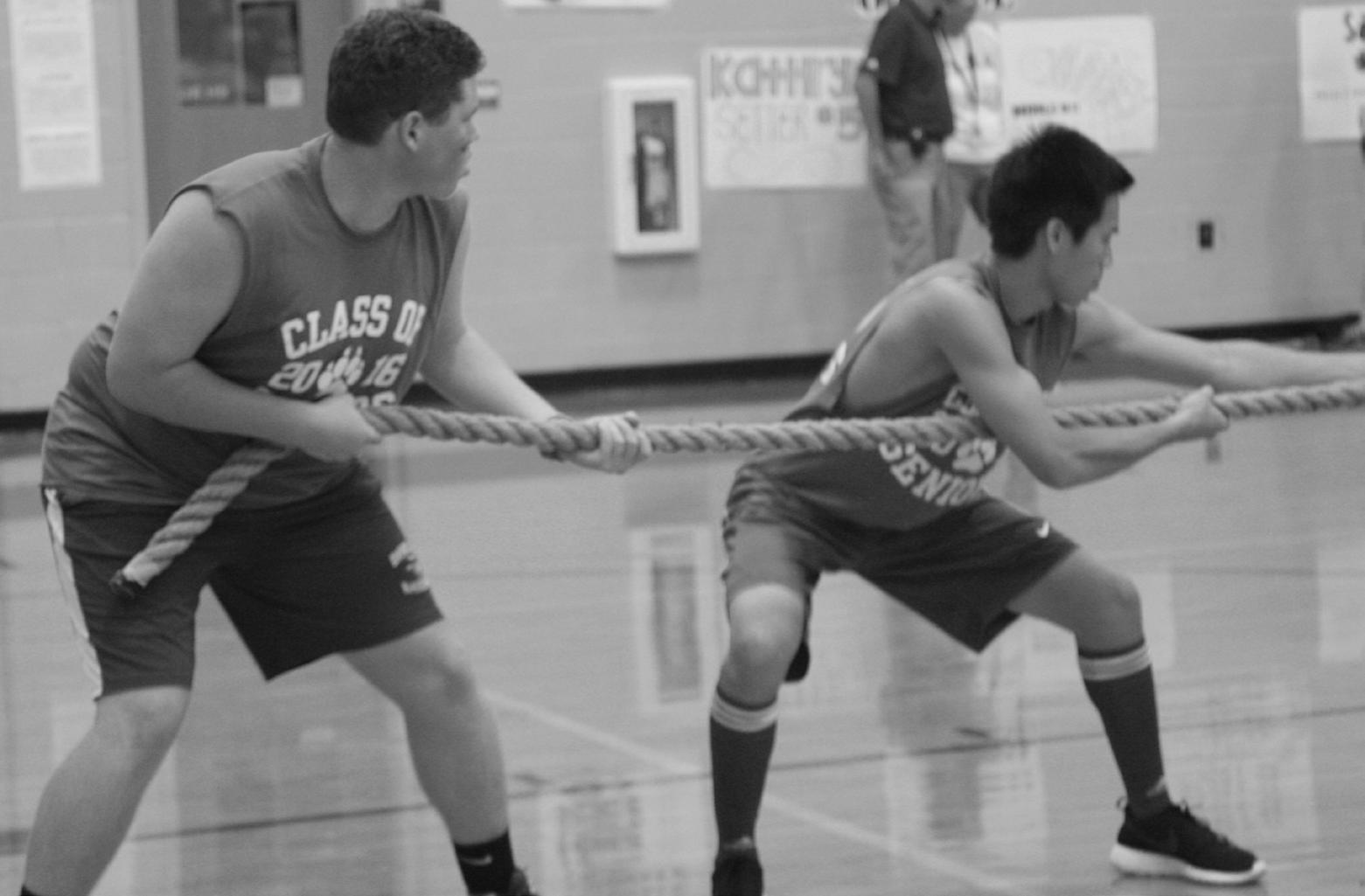
As the weeks of early September quickly flew by, there was one particular event that many students anticipat ed for: Spirit Day. Over the course of several years, spirit day as well as spirit week has grown more compliable with the administration’s standards, and although this is a seemingly positive action for ad ministration many students have shown negative attitudes to the changes that have come about. Peter Coppola (‘16) disagrees with the changes to the class colors, “I don’t like how they are changing spirit day for my senior year because I went through it all three other years and the fact that it is just changing this year is aggravating.”

Some of the changes that have been implemented include the col or changes for the grades. In previous years freshmen wore green, sophomores wore red, juniors wore black, and seniors wore blue. According to the senate, red and black were considered “too intimi dating” as this day fueled competition between the grades. The sen ate didn’t want to only change the sophomores’ and juniors’ colors therefore they changed freshmen to neon yellow, sophomores to neon pink, juniors are neon orange, and seniors are neon green. The Senate knew something had to change, and spent a lot of time de bating. Other changes include changing the previous class color day which was held on field day (the last day of spirit week) to the first day of spirit week, “We wanted something that would maintain the integrity of what spirit week is about but also something that might eliminate some of the hostility between classes,” said Class President
Although several students have discussed their opinion on the new spirit day changes, not all are negative. Specifically members of the senate, who were the students working to adapt spirit day into the standards preferred by administration, had more positive thoughts on the subject. Class president, Bella Saputo (‘16) is thankful that spirit day was still able to occur, “The changes were necessary so that we could have spirit week. The alternative was not having spirit week at all. These changes aren’t going to kill us and we still get to have this week of fun and school unity,” says Saputo.
Some students support while others oppose “As someone who’s been working with the senate for a long while, I am trying to make these changes that are obviously necessary and we tried our hardest to keep them as close to what they used to be,” states Tessa Oakes, a member of the class of 2016’s senate. Despite some students’ negative attitudetowards the spirit day changes, the administration is open to suggestions, “In a few years people won’t even remember how it used to be,” says Maegan Doody (‘16).
Many students reflected upon the high school’s 2015 spirit day more positively, “I feel like even though there were some changes that didn’t necessarily appeal to everyone, there was still the same energy and excitement as last year,” says Maddie Glass (‘18) however despite the excitement on spirit day students complained that the days leading up to spirit day lacked excitement.
Sarah Cusack (‘17) thought that this year’s changes were for the best and that spirit day was a lot more successful, howev er she also said that next year the senate should “create spirit days that are more attainable for most students. Things that you would be able to to find around your house; make it easier for everyone to participate [in the themes leading up to spirit day].” Milliken responds to students’ opinions on the new changes this school year saying, “All is open to feedback.”
-Andrea Staples Buiness Manager -Lydia Concannon News EditorSeniors gather to discuss strategies to win the events (PhotoCredit: Yearbook) Seniors Jeff Powers and Darnell Saravong compete in the tug-of-war competition. (Photo Credit: Yearbook)

tudy hard, excel in all your classes, put in your best effort out on the field, and save money for college.” These are just a few of the things that we as high school students hear on a regular basis from our parents, teachers, mentors, and peers. Here at Oyster River High School (ORHS) we have extremely high expectations of success in all aspects of our lives. Although we do our best, our main question remains: can we do it all?
It’s hard for high school students to balance rigorous sports, a full social life, and challeng ing academics, but if you can pull it off, having a part time job can be extremely beneficial. ORHS economics teacher Heather Healey expresses this concept of balancing gains and loss es in the economic term of ‘opportunity cost’. Opportunity cost is the concept of understand ing what you lose from alternatives when one option is chosen, and is a thought process that all of us do mentally every day. “Students have to decide what their sport or other extracur ricular activity is worth in their future in comparison to working. It’s a different story for everyone,” said Healey.
Everyone is in different financial situations, but we all could use a little spending money to make our stressful lives a little more fun. This is where the problem lies. What if you need money for gas so that you can get out of the house to see your friends, but you spend all your free time working to make that money. There are an infinite amount of contradictions that can be made on the discussion of prioritizing, but it is completely up to you to decide what you put at the top of the list. In the meantime, there are ways to save a little time and money here and there that can add up to make a big difference. “It’s a balance; you need to find a medium that makes you happy. Kids work so hard, and juggling sports, school, money, and friends is a constant struggle,” said Cheryle St. Onge, mother of current Oyster River student and two alumni.

If having some spending money is at the top of the list for you, but you don’t want to deal with working during the school year, a summer job could be the answer. “School and [High School students’] education comes before work, but if they have enough free time, use it to work and make some money for yourself,” says Paul Eja, owner of Pauly’s Pockets in down town Durham, and employer of many ORHS students. Luckily in the summer, it’s almost all free time so you get to make money then, and not have to worry about having time for the stresses of the school year.
Having a summer job has been a tradition for high school kids for decades, making money for a variety of reasons, but the intention was always the same: make money now so that you don’t have to later. If you have a good relationship with your boss or manager, you can speak with them about schedule management to make sure that you have plenty of time to do the fun summer things that everyone else is talking about. “I didn’t feel like I was missing out on anything socially because I was able to put in my availability. I could be flexible but it was also very easy to get the days off that I needed or wanted,” says Caitlyn Miller (‘16) after a summer of working at the recently closed Kaleidascoop in Durham. Summer is a time for hanging out with friends, making memories, and getting ready for the upcoming year, so be sure to leave time for decompressing. Not every second has to be spent doing something extremely productive.
If you are responsible and take care of your own financial needs such as gas, clothes and cell phone bill, you will most likely need more than just a part-time summer job. “It’s pretty stressful sometimes having to manage so many things, but it usually all works out as long as I communicate with my teachers, coaches, and boss,” says Liam Conrad (16’), who works a part time job year round while staying committed to his schoolwork and varsity athletics. Even if you do not necessarily need the money, it is always good to save some for when you do need it and can’t spend the time to earn it such as your first couple of years college. “Try it out, you might find that it’s manageable and leaves you with less stress in the end now that money is not an issue, but if it gets in the way of school then it is not worth it,” says St. Onge, who has experience with two children that worked during the school year, for multiple years. Oftentimes a job can have an impact not only on your wallet, but can teach valuable les sons. “Getting a paycheck can be more than just some money in your pocket, it shows kids how long and how much work it takes to make money. This makes them more conscious of how they make their own financial decisions in their life, as well as how they plan to spend money in the future, whether it be buying a house or going to college,” says ORHS principal Todd Allen.
If a high school student were to pay for their cell phone bill, gas, food not gotten at home, and clothes, the sum of the numbers is more than you might think. If you were to spend three dollars a day on gas, assuming you live about 10 miles from school and get 20 miles to the gallon when you drive to and from, then by the end of the year you would have spent over 500 dollars, not including weekends or any other ventures. If you bought a medium coffee from Breaking New Grounds every day on top of that, your yearly total would double. What about a monthly 70 dollar cell phone bill? Where is the money going to come from? Luckily, some OR students have some ideas.
“Keeping your change can add up quickly; if your parents give you money to grab groceries you can sometimes keep what’s left. Also, lots of local coffee shops have punch cards that get you a free coffee after you buy ten,” says Elizabeth Bulkley (16’) on how she saves a few dol lars. “Coupons are awesome. You can find them online, on receipts, or in magazines. I save so much with them and they’re so underrated,” says Miller. Thrift stores are also a popular choice. Some popular spots include Savers in Newington and Salvation Army in Portsmouth, both of which offer incredibly low prices on new and used clothes. There are also lots of hidden second hand gems in the smaller towns like Newmarket and even here in Durham. If you go out and buy lots of new clothes from thrift stores and find that you have no space left in your closet, selling your lightly used clothes on eBay or at a yardsale can leave you in the end with not only your new wardrobe, but also more money than you had before.
Although it’s tough, students here at Oyster River as well as students all across the country do their best to manage their time and money. The scheduling and stress can be gruelling, but you are slowly learning and gaining experience about how it will be when you reach the ‘real world’, which is extremely important.
ing, or even knowing their rights to full access to facilities offered to the gender they identify with. By publicizing to the student body and community that Oyster River is a school of tolerance by cre ating policies which clearly state the rights transgender students have, it can alleviate stress for those transitioning. Mike McCann, ORHS assistant principal explains, “Administration wants to make sure every student feels comfortable, supported, and safe at our school. This is essential for a healthy learning environment.”

ORHS student Emma Sourdif, (16’) a member of the LGBT+ com munity herself, explains why it is crucial to make the student body aware of the LGBT community within ORHS. She states, “I think it is very important for not only transgender students, but all stu dents to be aware and knowledgeable, which I believe would make life easier for the student body as a whole.”
Considering that creating policies to cater to every student en ables a comfortable work environment, it is imperative that other schools follow in our footsteps. Although, it isn’t necessarily an easy process. McCann explains, “Creating a new policy involves a lot of people- the superintendent, as well as the school board has to approve. The counseling department also had a significant role in the research that was necessary to make this policy go through.” Jason Baker, ORHS counselor, had approached administration alongside Limric, and had the primary role in writing the policy. He explains, “I was the one responsible for making any changes in
On June 26 2015, gay marriage became federally legal, and ever since there has been a significant influx of support from all across the country to keep this momentum going. Unfortunately, often times the other members of the LGBT+ community are given less attention. Until this last year, the Oyster River school district had no policy regarding specific rights for transgender students. How ever, with a push from students, administration, and Superinten dent James Morse, ORHS has become one of the pioneers for creat ing a transgender rights policy.

The new policy has been recently reported in Fosters Daily Dem ocrat. ORCD has been receiving recognition from around the seacoast area for their progressive decision to initiate this policy which allows transgender students to use facilities afforded to the gender they identify with. This includes the use of bathrooms, as well as locker rooms.
Oyster River student Nathan Limric (17’) identifies as a trans gender male and explains the initial interaction with OR faculty saying, “Talking with administration was a little uncomfortable at first only because when I first came out the policy wasn’t written so they weren’t really sure what to do.” The 2014- 2015 school year was the first time OR administration was approached by someone with a significant need for a policy. Administration took initiative to figure out the best way to implement it by asking Limric himself. Limric explains, “I felt very catered to during the process and I felt very included. My opinions were not only taken into consideration, but taken seriously.”
Being open, publicizing acceptance and assisisting for transgen der students at Oyster River is a crucial part in creating the philoso phy ORHS stands by, which is putting education at the forefront. To do this, eliminating any concerns a student may have by not hav
the policy, and doing research on certain definitions to make it all come together.”
Although it may be a multistep process, it is clear from all per spectives that it is imperative for other schools to follow in ORHS footsteps. Donald Maynard, teacher and department head of ORHS physical education states, “I believe Hanover, Bedford, and Souhe gan are in the process of putting a policy in place. I know that most schools will be looking at our policy to use as we are the first in New Hampshire to finalize one.”
Superintendent Morse further emphasizes how Oyster River is starting to become a model for other schools. In his interview with Fosters Daily Democrat he states, “I absolutely believe this policy will influence other policies and we will be at the forefront of this particular issue”. He wraps up the interview with a simple, but very crucial statement saying, “These children deserve and need our support,” and I couldn’t agree more.
-Jessie Stelter Layout Editor“When I first came out the policy wasn’t written so they weren’t really sure what to do”. -Nathan Limric (‘17)
“Administration wants to make sure every student feels comfort- able, supported, and safe at our school.” -Mike McCann

We all know the feeling, staying up until the last hour doing homework, only to wake up a couple hours later to drag ourselves out of our beds and into the school hallways. Our eyes barely open as we listen to teachers’ talk to us about things we can’t seem to appre hend.
Sleep is not only vital to a student’s well being, but it is also vital to their education. In “Teens and Sleep,” pub lished by the National Sleep Founda tion, it states that teens need about 8 to 10 hours of sleep each night to func tion best, however only around 15% of teens reported sleeping 8 1/2 hours on school nights. Not getting enough sleep can be detrimental to the brain and its function. This can have an impact on the availability for a brain to learn and comprehend information.

Most students would agree that they don’t receive enough sleep during the school week. Homework, after school activities and jobs can make it difficult to get to sleep early. The average teen ager gets between 7 and 7 ¼ hours of sleep a night. This is way lower than the recommended amount of sleep of 8-10 hours a night. Zach Kaplan (‘16) states, “I think that some nights when I have way too much homework it affects how I do on quizzes or tests. I think that if we were given less homework it would be easier to get more sleep and there fore do better on tests and quizzes.”
The amount of sleep that a student re ceives is not only based on the quantity but also the quality. The quality of your sleep helps with your learning and memory in two ways. First, a sleep de prived person cannot focus and there fore cannot learn efficiently. Second, sleep itself has a role in memory, which is essential for learning new informa tion.
Not only do students agree that they aren’t receiving enough sleep, but their teachers have noticed it as well. Stu dents are not as attentive first period because it can be hard to concentrate after a night of very little sleep. Home work as well as after school activities are overwhelming and can cause stu dents to postpone homework to a later time.
Waking up in the morning and going to school is especially difficult after you have been up late doing work. I find it difficult to concentrate during class when running on few hours of sleep. “First period is difficult because people just come in not quite awake and there fore they don’t have that motivation to keep going throughout the whole day,” states Mary Beaton, a teacher at Oyster River High School.
Most teachers agree that their stu dents aren’t sleeping enough each night however over the years not much has been done to reduce the amount of homework a student receives each
“What we see nowadays is stu dents walking in with their giant coffee that has high caffeine or high sugar. Caf feine can help you wake up but relying on it too much can damage your health,” says Danuta Richards, ORHS Nurse
night. The Brown Center Report on Amerrican Edu cation has found that high school students have an average of 3.5 hours of homework per night, however the same report published by the Brown Center in 2012 stated that 87% of 17 year olds spent two hours or less on homework per night.
This shows that on average the amount of homework has increased by a shocking 1.5 hours in less than three years. High school students across the country can agree that an unreasonable amount of homework causes lack of sleep and lower quality of sleep.
The thought that comes into everyone’s head when faced with these statistics is “Why don’t teachers just give less homework?” It’s not always that easy though. Most teachers try to make their homework helpful and most of the time it is, but they don’t always realize that each students has homework in five or six classes a night and can’t always compete their homework. Bea ton, who teaches Spanish at Oyster River mentions, “I purposely try to make my homework meaningful.”
Homework can also help students do better in their classes but a large amount can cause them to be over whelmed. Since 2005 many psychologists and doctors have linked ADHD (Attention-Deficit-Hyperactiv ity Disorder) with sleep disorders. The symptoms of ADHD mirror those of sleep disorders. These symp toms include problems with concentration, memo ry, impulse control and organization. Not everyone suffers from ADHD but a lot of people suffer from a lack of sleep. All of these symptoms can cause a loss of focus in school which can be harmful to a student’s grades. “There’s definitely a direct impact with their performance here at school,” states Kim Cassamas, an ORHS Counselor, when regarding how sleep affects student’s grades. “I encourage students to get onto a set sleep schedule, even if they have to train themselves to learn to get enough sleep.”
A solution for students that aren’t getting enough sleep is to prioritize sleep over other not important things. People tend to use technology or get distracted by other things and put off sleep. It’s not always easy to prioritize sleep but it is important. In order to receive a better night’s sleep one should set a sleep schedule. If you sleep more each night it will show not only in school but also in your well being. Your health and your mood are dependent on how much sleep you re ceive a night.
Students notice when their grades aren’t doing as well and when they are suffering from lack of sleep, which is more often during the school year than not. Kobi Hackenburg (‘16) who is taking AP classes and is also on the cross country team states, “Having home work, a sport, and trying to get sleep can be very over whelming at times. I find that my grades are affected by how much or how little sleep I receive.”
Some people try to make up for a lack of sleep with temporary solutions such as caffeine. The National Sleep Foundation website states that because caffeine is a stimulant, most people use it after waking up in the morning or to remain alert during the day. While it
is important to note that caffeine cannot replace sleep, it can temporarily make us feel more alert by blocking sleep-inducing chemicals in the brain and increasing adrenaline production. Danuta Richards, the school nurse at Oyster River states, “What we see nowadays is students walking in with their giant coffee that has high caffeine or high sugar. Caffeine can help you wake up but relying on it too much can damage your health.”
There are many causes to lack of sleep and many tem porary solutions however there is only one long term solution and that is to get more sleep. In order to sleep more one must go to sleep earlier, which is easier said than done. Many people want to get more sleep than they acquire but other things can get in the way. “I get home late from sports and then I have to do home work, shower, eat dinner and get ready for the next day so I guess a mix of all these prevent me from getting enough sleep,” says Eleanor Zwart (‘18).
A lot of people think putting off sleep gives them time to complete their homework or study for tests. For example somebody might think, “If I stay up late studying for this test then I will do better” but in real ity they do worse because they are too tired to remem ber any of the information given.
A controversial topic that is being studied by the ORHS Counselors and Faculty members at the Univer sity of New Hampshire is the debate about later start times. Some people believe that later start times would help high schoolers get more sleep and do better ac ademically. Issues such as after school activities have come up when discussing the subject and is a ongoing debate but it could be a solution to getting more sleep. “Our classes start at 8 but on some days I have sleepins meaning I don’t have to be in until 10 or so which is nice because the workload requires that I stay up late so I don’t get as much sleep as I should,” replys Sydney McKiernan (‘17), a student at Phillips Exeter Academy. Another suggestion is for teachers to cut back their workload. Homework is important but an hour every night in seven classes can be severely overwhelming. It would be unreasonable to say that teachers should just stop giving homework all together but reducing it a little would help students excel academically. In or der for students to well they need sleep and in order to sleep they can’t be up until the late hours of the night doing homework. A lot of pressure is put onto students nowadays to succeed and to be a well rounded indi vidual. But how can a person juggle homework, work, extracurriculars, family time, and friends?
The answer is simple, you can’t. In order to succeed in school you have to balance a lot of these and sleep. In order to get more sleep it is important you you set a regular bedtime, wake up at the same time every day and if you’re still not getting enough sleep try napping to make up for lost sleep. Sleep improves your overall well being and mentality and if you don’t get enough of it it can be detrimental to your education and your health.
-Lydia Concannon News Editor“I feel whenever I had to introduce myself I would have to say I was from Barrington. I wish we were just all considered freshman, not Barrington and Durham kids,” says Brianna Rybinski (‘18), former Barrington student.
The 2015-2016 school year had a record breaking enrollment of 100 students from Barrington. Oyster River made an agreement with Barrington to accept a minimum of 80 students for the 20152016 school year and then each year that number will go up by 20%. Once there are 125 students from Barrington, Oyster River becomes Barringtons primary highschool, and with that there will be transportation and other accommodations.
Oyster River first accepted Barrington students seven years ago. This was a huge step for Oyster River and a tough transition for those few freshman entering the school knowing no one else. When growing up in the Oyster River district, by the time you get to high school you’ve been with all these kids for four or maybe even ten years depending on what elementary school you went to. High school seemed like a big step but imagine that transition as well as being “a Barrington kid”.
shouldn’t matter where you came from before high school but nat urally kids can be cliquey even if it’s not intentional.
Advisory is something that will hopefully help with eliminating the title of “Barrington student.” Students of the same grade are randomly selected and put in a room with 10 to 13 others that they may have not necessarily known before and it’s a great chance to get to know someone new. For the freshman class they will be with the same 10 to 13 kids and same teacher for all four years of high school. “The reasons we feel the advisory program we are starting is important is we are hoping to bridge some of those social gaps for kids,” says Allen.
Another outlet for students to get to know each other is playing a sport. It’s a great way for any new student to get to know some one, “Being a part of the cross country team I made a lot of friends pretty quickly. That was super important,” says Casella. Building friendships with students in different grades and from different schools is vital and can drastically change your high school experience. This year especially Oyster River has really been focusing on unity. Changing the “junior core” to “middle floor core”, having sophomore and junior lockers in it as well as rearranging color day on spirit week are two big changes made this year.
Feeling segregated and being “the Barrington kid” isn’t a title that stays with you forever. After freshman year most students have found their place and are adapted to the school. “Freshman year, I didn’t really know anyone, I struggled in my classes and I wasn’t participating in out of school events,” says Samantha Tenney (‘16), “over the past three years I have made really good friendships, gotten better at handling my work load and staying focused in class and I spend a lot of time at school events and participating in class events.”
Not everyone views the transition from schools as a bad thing. 8th grade Barrington Middle School student, Taylor Bennett, is excited for the change. “It’s nice that you get more of a choice in where you want to go but it’s also difficult to choose. There’s like pros and cons of both sides but I prefer being able to have a choice in the high school I want to go to instead of going to my town’s high school,” says Bennett.
As of today ORHS has 102 students from Madbury, 207 from Lee, 304 from Durham and 100 from Barrington. The number of Bar rington and Madbury students are almost equal. “That just gives you an idea of proportionally, we think of Madbury as being one of us, when Barrington is the same number of kids the only differ ence is they didn’t go to middle school,” says ORHS principal, Todd Allen.

“Moving to the Oyster River School District was weird at first but I’ve settled into things, says Cameron Schiavo (‘19) “I had to meet a lot of new people my age which felt different because I had known the same group for roughly eight years.” Freshman from Bar rington this year are being introduced not only to high school but to hundreds of other people they don’t know yet.
“In the beginning of freshman year if there was not another Barrington student in any of my classes I was all alone and felt segregated in a way,” says Cam Casella (‘17), “I think that the fact that there are the same amount of Madbury students as Barrington students is a great thing, and that the best thing students at ORHS can do is treat the Barrington kids the same way they treat each other.”
The hope for the future is to eliminate the title of “Barrington stu dents” and help new students feel more comfortable. Most students say by the time they get to junior or sometimes even sophomore year, they’ve already forgotten who is from Barrington. It really
“The biggest challenge I think for students is the fact that the BMS academic program and ORMS academic program are not the same,” says Allen. It’s expected that in the next three years ORHS will have 125 students from Barrington and a school population of roughly 800. More students means more teachers and more classes which allows a larger variety of courses to be offered and we will be able to match both middle schools academic systems. “Oyster River was definitely a little intimidating because the students did seem more prepared and slightly ahead academically compared to Barrington students,” says ORHS and BMS alumni, Taylor Rioux (‘14).
During high school you meet students from all different grades and start new friendships that could last a lifetime, will it really matter who you went to middle school with? “It’s hard to know how to talk about kids from barrington without saying ‘the bar rington kids’ as if they were a separate thing, but at the same time we want to accept that they’re here. I guess one thing we all need to work on is how do we be more inclusive,” says Allen.
“Over the course of four years I began to feel more and more like I had belonged, that I was an Oyster River kid,” says Caitlyn Lasher, ORHS alumni (‘15), “I constantly had people tell me they had no idea I was a Barrington kid or forgot that I hadn’t grown up with them.” This is the ideal situation and what it seems most Bar rington students hope for, and it is possible. Soon enough I believe that the title of “Barrington student” won’t be seen as segregation or an insult but simply acknowledging where they came from. They are a big part of our school that should be more appreciated.
- Betsy Larson Social Media Manager“GRADUATING HIGH SCHOOL FEELS PRETTY GREAT, NOW IMAGINE THE SAME FEELING FOR COLLEGE GRADUATION. NOW IMAGINE THAT FEELING DIMINISHING AS YOU THINK OF THE $50,000 IN LOANS YOU HAVE TO PAY OFF, THE CAR YOU BOUGHT TO COMMUTE TO THE JOB THAT ONLY PAYS $35,000 A YEAR AND THE LINGERING FACT THAT YOU WILL PROBABLY HAVE TO MOVE HOME,” SAYS OYSTER RIV ER ALUM AND NOW UNH SENIOR ALEX HARLING.
As the college tours and interviews windle down and applica tion deadlines creep around the corner it’s time to be brutally hon est about the colleges you are applying to. You have talked circles around campus life, dorms, academics and study abroad programs but what about the topic no one wants to discuss? The tuition bill that will be arriving at your doorstep in a couple months and how you are going to pay for it.
The problem this generation is suffering from is that debt is be coming a norm. The cost of the school is the last thing most stu dents look at. Most students at Oyster River will start touring and talking of college around sophomore or junior year of high school. Jumping all around the country for colleges tours regardless of the tuition bill that comes with the beautiful campus, new dorms, and mountains of extracurricular activities. Now those colleges you toured that were clearly out of your price range have become your top choice. And suddenly the only way you will be able to afford the school and not but your family into financial turmoil is to take out loans. One loan is not too daunting but multiple that by four years and the possibility of graduate school and you are looking at mountains of debt.
“There is a lingering belief that people who go to ‘better schools’ get better jobs. That is an outdated thought. What holds true is working hard and finding what you want,” says Harling.
“College is the best four years of your life”, “Choose a school that will make you happy”, “Pick a good major and your loans will pay themselves off”, “Taking out loans is part of the college process” sayings like these have become social norms around our country today. People have become numb to the words ‘college debt’.
According to an article done by Inside Higher Ed, Not Worth It referring to an ongoing study at Gallup-Purdue University says, “Graduates who took out student loans of any amount, 33 percent said they strongly agreed that their education was worth what they spent.” This percent dropped even lower to 18 percent when graduates took out loans of $50,000 or more.
“I will not go to a school if I am going to graduate with significant debt. It just wouldn’t be worth it, no matter how badly I wanted to go,” says Evan Gordon (‘16).
Most students look to Merit scholarships, higher SAT scores, and local scholarships to lessen the blow of the tuition bill.
“I will be applying for tons of scholarships, and I really need to work on my SAT score so that I can qualify for more money,” says senior class president Isabella Saputo.
According to an article for The Huffington Post, 10 Fun Facts About the Student Debt Crisis, more than 40 million people in the United States have student debt. The class of 2015 graduated as the most indebt class yet.
“My brother went to Rogers Williams with an okay financial aid package. He was a stellar student, had a 4.0 in undergrad. He grad uated with $90,000 in debt and was unemployed for a year and a half,” says ORHS counselor Kim Sekera.
Questioning if higher education is worth it is not something that shouldn’t even be a question. The question that most seniors should be asking themselves is if the education from their most ex pensive school and their least expensive school are different. The answer is likely no.
Bridget Regan, an ORHS graduate, attended Guilford College for her freshman year and then transferred to the University of New Hampshire for the remainder of her undergrad years. “Pay atten tion to the amount of student debt you’re going to graduate with. I told myself that as a Durham resident I would never go to UNH, but the amount of aid and scholarships I received from them made them hard to ignore,” says Regan.
When Senior Associate Director of Admissions for New Hamp shire at UNH, Tara Scholder is asked what her biggest piece of ad vice for navigating the finances of college application process is she says, “include a range of schools in your application set, includ ing at least one instate public institution,”
Scholder continued by saying, “while a college degree continues to be a worthwhile investment, families are considering more how much in college loans they want to take out. Universities and col leges have a range of tuition costs.”
It’s time to ask yourself, do you really want to spend the rest of your life paying off four years of your life?
Isabelle Todd Features Co-Editor
Remember the days of elementary school when education was focused around our imagination - drawing, painting, making music, writing stories, reenacting plays, getting messy? Why does this seem to stop once we reach late middle school and high school? Why is our education system diminishing our natural power to use our creativity?
Ken Robinson, an English author, speaker and international advisor on education in the arts, did a TED talk a few years ago on how education systems around the world are killing creativity. With more than 32 million views, his TED talk has com pletely changed the way that many educators, parents and students view the education system. If you haven’t seen it, I highly recommend taking a few minutes to sit down and listen to what this man has to say.
Think about it - Have you ever taken an elective that you’ve been interested in but lost passion for it because you were forcedfed the knowledge in a standardized way, then were rigorously tested on? How are you supposed to have passion for a subject when this is the way we’re taught? Robinson states in his video that “kids are innovators and kids have talent. Creativity should be just as important as literacy.”
Creative thinking is an essential skill that we should continue to carry throughout life. Students who are creative thinkers add a lot to team dynamics. One who is creative is often clever and can find solutions to harder problems by thinking outside of the box. When discussing this topic with ORHS art teacher Tim Lawrence, he mentioned that “major engineering companies are now looking for applicants who have minored in the arts because they are typically creative thinkers; they think outside of the box, instead of in a linear way.”
Schools in the U.S. have been referring to the acronym STEM, which is an education policy which stands for the programs of study: science, technology, engineering and math. STEM is used to improve competitiveness in science and technology devel opment programs which is suppose to teach students to think critically in the classroom. This policy, however, doesn’t teach students to think creatively. This acronym has caused much debate over the fact that art and humanities were excluded from the policy. In 2009, the acronym changed from STEM to STEAM to include the arts, because creative and critical thinking are believed to be important assets in the classroom and in the real-world.
In his TED talk, Robinson made an interesting point that education systems around the world build this hierarchy of aca demic subjects where mathematics, science and language are at the top, and humanities, music and arts are stigmatized at the bottom. Pam Raiford, ORHS philosophy and psychology teacher believes that this is problematic.“We prioritize certain sub jects over others, which I think is a problem. Math and science are clearly very important, but I can’t imagine what we would do without music and arts,” said Raiford.
Assistant Principal, Mark Milliken explained how schools are preparing us for the real world. “In high schools today, other courses are emphasized more through a practicality standpoint. Schools missions are supposed to prepare students for life after school.” Milliken explained how his daughter was really talented and interested in the arts, and thought about going to art school. “We encouraged our daughter, Aimee, to follow her passion in the arts but she had to ask herself the practical question of: can I make a living by doing [art],” explained Milliken. Milliken’s daughter, Aimee, is currently an ICU nurse in Boston.
Although subjects like humanities and arts may not demand the amount of critical thinking like other disciplines do, I believe that these courses demand a creative and clever mind in order to succeed, that not everybody may have. There are many people who are incredibly talented in the arts or music, but they aren’t recognized or rewarded the same as someone who is academically stronger in science or math.
“I think that art and social studies subjects are important but science and math subjects are definitely valued more,” said Emma Sassaman (‘17). “Art classes are just electives, whereas math, science and language classes are required,” added Sassa man.
This raises the question: why aren’t there any required art classes? Art should somehow be integrated into our everyday curric ulum. It’s a good way to give our left sided brain a break, and let our creative, right-sided brain be active. Integrating art into everyday classes would overall, make us better thinkers, creators and innovators.
Robinson mentioned that the culture of education is all about standardization, and it’s true. Students are evaluated and grad ed on their standardized test scores. How can this possibly be an accurate depiction of a student’s academic talent when all students learn differently and at their own pace? Some students are also stronger at other subjects that don’t show up in these standardized exams.
Teachers aren’t meaning to do this to their students standardization is doing it to them. This is why kids across America are dropping out of school, because the structure of public school isn’t work for them.
Sitting in rows all the time and being talked at isn’t an effective way to educate kids who are in their teenage years and are already thinking about a million other things. Breaking up into groups, discussing and working collaboratively engages the mind and motivates us to learn and gain knowledge. This is something that our nation’s education system needs to start focus ing on, because standardization isn’t working. It’s also excluding creative subjects.
“One thing we’re are working on as a school is personalized learning versus standardize learning,” said principal, Todd Allen. Oyster River is special in the sense that teachers here are really trying to focus more on personalized learning for their students and how to think critically and creatively. “It really depends on the class and teacher, but if education isn’t getting students to get together and think critically, creatively and engage in the material, then it’s not enhancing student learning,” said Raiford.
By personalizing learning and integrating creative classes into the daily school curriculum would really transform the educa tion system and the way that students learn and think. It would also take away from the competitive aspect on who is smarter than who. Everyone is unique in their own way and should be able to show that whether it’s through a project or paper, not a standardized test.
Jake Garner Op-Ed Editor Creative Director

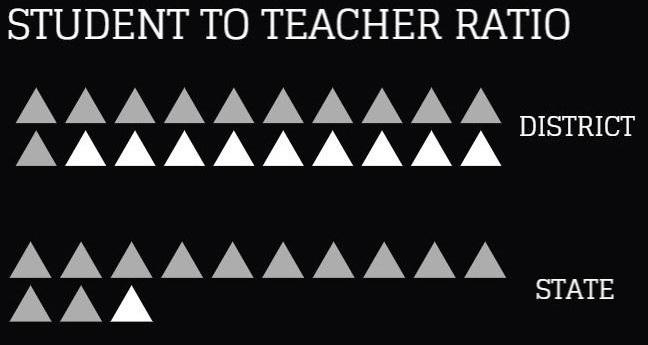
think kids at Oyster River High School should realize there are a lot of great things about their school that they shouldn’t take for granted. Even though classes are more challenging, you are getting a better education and should be real ly grateful for that,” says Savannah Casper, (‘17) who transferred from Oyster River High School to Connell High School in Connell, Washington this past summer.
On paper, Oyster River seems like the perfect school. According to the ORCSD Annual District Report, ORCSD is, above average SAT scores, the student to teacher ratio and class size are well above the state demand, high graduation rate, high college attendance post grad, low drop out rate and named the second best public high school in New Hampshire by US News. So what is Oyster River doing to create this environment that deems us such a top school?
“We are small and we have money. I think those are two huge things that when you have a classroom of under twenty two stu dents you get to know your teachers better and teachers get to know their students better. And you’re able to provide a richer curriculum with smaller class sizes. Additionally, we have a lot of resources available to us which is not the case for a lot of schools, so when we need something we usually get it,” says Social Studies teacher Brian Zottoli.
So what do students who have attended other high schools have to say about Oyster River?
Shaeleigh Bellen moved from Oyster River to Azle High School in Azle, Texas at the beginning of this year, going from a school with 700 students to a school with 2,000 students. “I pre fer Oyster River because it’s a smaller school and the teachers can reach out and provide help when it’s needed to any students,” says Bellen.
Victoria Madore (‘17) is a new student at Oyster River this year. When was asked what the differences are between Oyster River and her prior school Lewis Mills High School in Burlington, CT she says ORHS is a more relaxed environment and that the teachers treat their students more like “college students.” Madore goes on to say that ,“the schoolwork is more difficult, the learning pace is faster and there is much more independence,” compared to her old school.
Unlike Madore the Casper sisters said goodbye to Oyster Riv er and hello to a new high school. Moving across the country to Connell High School, after spending six years in the Oyster River community.
“At Oyster River, I was doing an average of 2 hours of homework per night and here I’m only doing about 1/2 hour, if that,” says Ken non Casper. And as far as course difficulty Savannah Casper ex plained the difference by saying, “I am enrolled in three different
classes that I will get college credit for and they are way easier than most classes I took at Oyster River. My non college classes, I never get homework in and they are not difficult at all.”
Oyster River unlike Connell High Schools allows the use of cell phones, leaving the room during class, and eating lunch outside.
“I definitely think that students at OR have a ton more freedoms and are trusted more by teachers,” says Savannah Casper.
Nick Avery-leaf transferred to Exeter High School last year and is now back at ORHS for his senior year. While the shorter commute time and desire to see his friends more were his most driving rea sons for coming back, he had some other reasons as well.
When Avery-leaf is asked what he thinks some of Oyster River’s strengths are he comments by saying, “We are a pretty tight knit committee. We don’t all love each other but everyone is accepted and respected.”
Due to Oyster River’s small size students are given many more free doms than other schools give out. Such as senior/junior privilege, variety of class selection, not needing passes to walk in the hall and cores.
When Dean of Faculty at ORHS Mark Milliken is asked what the biggest difference between Oyster River and other schools he responds by saying, “the kids here are very well behaved and they show a lot of respect. And the teachers here really like teaching and really like being here. There is a lot of freedom and trust for students, there is a constant dialogue between teachers, students and administration.” Milliken continued by saying, “when there is a rule or expectation students may not like it but they understand it, or at least they have had the opportunity to understand why. It’s not just do it because we said so.”
It is clear as you walk the halls of Oyster River the school is about many more things than just upholding its high testing scores. Through the variety of staff and students, Oyster River is able to offer an education many other public high schools aren’t able to.
“This school is an exceptional place. In a teacher sense this school is a career school. When you get into Oyster River you stay at Oys ter River. We have a really educated group of faculty that are very unique. On the other side of that I find the students here to be really exceptional human beings. I work with a hundred students a year that blow me out of the water, and that’s unique. Having a class room where even the most unmotivated student is engaged and is curious and is sharing ideas is a really cool thing that just doesn’t happen other places,” says Zottoli.
-Isabelle Todd“YOU ARE GETTING A BETTER
AND SHOULD BE REALLY GRATEFUL FOR THAT”


We are currently facing a global crisis. One where matters of life and death, rescue or abandon ment, have all been boiled down to policy and semantics. Like we have seen in the world’s re sponse to the Syrian refugee crisis, which has proven to be one of the most heart wrenching and deadly set of circumstances in recent years, many humanitarian crises have not been properly addressed by the West. Part of the reason that we have failed to react appropriately is due to our culture’s lack of empathy and, more importantly, because the public is not caring to care. While there is much speculation to be had on this topic, through the statements made by politicians, the policies that have been installed, as well as the public’s general attitude, it can be concluded that the West has not fully internalized Syria’s struggle. While this is a tragedy, it is only a symp tom of a far greater problem: our detachment from what is happening around the world.
Often when faced with cumbersome and ex istential issues, especially one such as Syria, I find that one of the easiest ways to cope is through dissociation. Setting one’s self apart from the dilemmas in the news can certainly help reduce potential heartache. “I have definitely found the [news media] upsetting. Sometimes not watching it is just [easiest],” says Liam Conrad (‘16). Similar to Conrad, I feel that separation is the easiest way to guarantee less exposure. For example, the act of put ting up an emotional divider between me and the refugees leaving Syria has allowed me to not become upset by their peril, and instead continue living where I am now.
As much as this manner of thought may help you rest assured, it is in fact, very dangerous. To think about a Syrian refugee’s plight only as a struggle that is thousands of miles away and across an ocean, will cause you to lose potentially vested interest. This emotional barrier, so to speak, that much of the world has used, has caused millions of people’s lives to be put at stake. This separation from very present issues includes not only the general public, but those in political office. In fact, much of our reluctance to step into events such as Syria likely stems from pol iticians’ deliberate dissociation. Because of this, the decisions being made about world issues, and spe cifically Syria’s refugees, have largely been with eco nomic or political interests in mind, rather than the very pressing humanitarian interests.
Whether this dissociation is deliberate or subcon scious, it is present to some degree in everyone. “We compartmentalize and separate ethics from so many aspects of life when in fact, they are very imbedded,”
Pam Raiford, a teacher of sociology and philosophy
says that what worries her is when people say, “‘Oh, that’s a political issue, I don’t have to deal with it,’ as if that separates [them] from the moral issue at hand. They go hand in hand. It is so critical [to see that.]” To differentiate between ethics and politics is to not see the entire matter. It lifts some of the weight from the observer and, therefore, some of the responsibil ity to act.
If our society was able to fully see the magnitude of world events, and truly internalize their wide range of implications, we would be able to make a serious change to the Syrian crisis among many, and the toll it is taking on so many individuals, It definitely will not be easy and it may be uncomfort able, but to recognize, and more importantly, care, about these people’s livelihoods will set us on the right track. This point can be perfectly illustrated in the photo published of Aylan, the dead Syrian child found washed up on the beach. Hundreds of thou sands of refugees had been risking death to search for safety, yet it was not until the photo of this boy, face down in the sand, surfaced that the public was able to fully pay attention. To the audience that nor mally does not pay attention, these heart wrenching stories are what it takes to pull them in. While this additional attention to the issue brought support, it was far too late. The photo of the boy came four years after the first refugees began to die. We, as a society, cannot wait this long for the public to become invest ed. Our country cannot hide from these issues, just because they are out of our comfort zone. If we as a society are not involved, or personally affected, we tend to disregard the situation.We must be conscious of the state of affairs and we must be willing to put genuine thought into our role in them.
What the West is now dealing with has been chalked out as a great moral dilemma, worthy of political debate and “sides”. In fact, it has become such a controversial issue that for a period the Eu ropean Union was unable to come to a decision on what to do. This has created room for debate, and allowed opposing viewpoints to surface on an is sue that should have only one side, with different approaches.
The refugee crisis that Europe and the Middle East are currently trying to deal with has been cata strophic. “It was really devastating when [the civ il war] started”, says Sana Ashraf, a 1st generation Syrian American, “the summer before everything happened, we were in Syria having the time of our lives”. The conflict began in 2011, after the Assad government began to violently crackdown on it’s citizens and has escalated to the present. Ashraf recounts that “the area in Syria we’re from is proba bly one of the worst hit cities in the country.” Using poison gas, terror bombings, torture, and deliber ate civilian beatings, Assad has managed to keep control of the tattered country. “My family and most Syrians didn’t think the situation would get to this point at all”. Because of recent increases in bombings and attacks, more and more Syrians have shared Sana’s sentiment in realizing that the situa tion may not get better, and consequently have de cided that they cannot stay. While this is the most recent event of this nature, they happen in varying degrees around the world. Syria’s terrible circumstances have led to the influx of refugees that is now washing through both Eu rope and the Middle East. According to the United Nations High Commissioner for Refugees, “Over 3 million have fled to Syria’s immediate neighbours such as Turkey, Lebanon, Jordan and Iraq.” And because the country now has no support services, over “6.5 million [people] are internally displaced within Syria.” These people live in refugee camps with tents and no running water, fearing for their lives.
The bitter reality is that now, more than ever be fore, we can no longer turn a blind eye and remove ourselves. The events happening in Syria and the Middle East are only going to become more and more frequent. We are entering an era where en tire political entities teeter on failing governments. Years ago, these systems may have found a way to get by, but because many of them are in areas prone to extreme climate events, they will now fall faster, harder and more frequently than we have ever seen. While the Syrian crisis was founded on
political instability and spurred by droughts and famines, other possible catalysts could include hur ricanes, tornadoes, forest fires, floods and changes in temperature.
This means that the problems we are seeing in Syr ia will no longer be limited to the Middle East. “I was working in a small town with many issues fac ing their area,” recalls Leigh Cameron, a member of the Peace Corps who spent time in Senegal for sev eral years. “The rainy season was incredibly short, and it caused a lot of problems for the farmers and their production that in turn had a ripple effect on their surrounding communities.” Because of glob al climate changes impending effects, we will see situations similar to this happening more and me. And to think that putting them out of mind will mitigate their damage is asinine. According to Kev in Gardner, a professor of Sustainable Engineering at the University of New Hampshire, “there are ex treme climate and weather events that are becom ing more common. We have already seen them, and the number of really expensive disasters in New Hampshire has gone up. We are already having to spend millions of dollars to repair things such as our infrastructure.” These events are only going to continue to happen, and soon it won’t be tropical storms and mild flooding seen in New Hampshire, but rather extreme climate disruptions and their ef fects that will be knocking at our door.
It is so easy to pin this problem on someone else, some other country or entity, but the reality is that it is all of us. Dissociation is what causes the collec tive indifference towards both our future and our present that is allowing these horrendous events to happen. There are Syrians that were doctors, law yers, teachers and musicians now drowning and starving and yet all we can muster is, “‘What is Romania doing?’, ‘What is Hungary doing?’ ...the real question we should be asking is, ‘What are we doing?’” asks Raiford.
I understand that this is easier said than done, and over simplification of an issue this large is unfair. An entire culture’s opinions cannot be changed on an issue, no matter the severity, overnight. And to approach realities such as this refugee crisis head on, it is going to take effort and great support. “It is really easy for people to continue living in the way that they are living and not see the impacts around the world, ” says Cameron, “but it’s not happen ing fast enough. The urgency of these [crises] is so huge and immediate and we can’t take action on this quick enough. Everybody needs to become in volved.”
-Conrad C. Dundorf
“I think that if the solar panels are implemented in the right areas at the right amount it could really improve the situation of ORHS as a sustainable community. On top of that I do believe that it would also be a wise decision from an economic standpoint, seeing as they will be generating energy for the school or at least feeding some into our local power system,” says Oyster River High School stu dent and Sustainability Club member, Tim Morris (16’).
If Oyster River was to become more dependent on energy efficient ways to replace the electricity used at the high school, this would not only be beneficial for ORHS financially, but Oyster River High School could become significantly more environmentally friendly. One of the most dependable, realistic, and efficient ways would be solar energy.
In a report regarding the finances used at Oyster River High School in February of 2015, it showed that electricity usage in the building increased 3% from the prior year.

In order to address issues such as as this, Cristina Dolcino explains that “the collaboration with the School Board to develop a Environ mental Sustainability Policy was influential because it represents the District’s commitment in reducing our ecological footprint and supporting sustainable practices,” Dolcino is the Moharimet Ele mentary School representative for the Durham Energy Committee.
Right down the road from Oyster River lies Exeter High School, a school that may be one of our rivals when pertaining to athletics, but a school to replicate when regarding their solar energy program. A local company located in Madbury, Revolution Energy, worked with Exeter High to create their sustainable energy program. With EHS at an enrollment of 1691 students, and Oyster River at an en rollment of 673 students, Exeter’s facility is presumably larger than Oyster River High School. Though the initial investment of the so lar panels at EHS may be exceeding Exeter’s budget, eventually the cost of the solar panels will “pay itself off.” The solar energy will be sent back to the power plants where Exeter will be payed for how much solar energy they are contributing to the power plants. Exeter will also be saving money by not paying for the expenses of electric energy.
Like Exter, Oyster River will have a high initial cost, but eventually the school will be able to pay off the debt and begin to save.
After 10 years, EHS will own the 465 solar panels that were pur chased for their school. According to a report done by Foster’s Dai ly Democrat, “Solar Energy: Affordable Alternative Energy” after the installation of EHS solar panels, the money saved in the first year reached approximately $20,000. Exeter will purchase the en ergy accumulated by the solar panels over the duration of 10 years
“Back in 2012 we had a complete energy audit complete for Oyster River High School and one of the recommendations that were made was to look into using solar panels. We are definetly a school that could benefit from the use of solar panels.”
-Todd Allen
to compensate for the cost of the installation. After 10 years, while the price of energy increases, EHS will be paying approximately $150,000 for energy. Whereas through a traditional energy source they would be paying $170,000 each year, a $20,000 difference.
Exeter High School currently has 465 solar panels, producing 100 kWh (kilowatts per hour). In relation to Oyster River High School and their efficiency with electric usage, in 2013 sustainability com mittee report stated ORHS used 1,568,121 kWh throughout dura tion of a year. To make numbers more relevant, let’s say for each day of the year (365 days) ORHS uses 4355.89 kWh. If ORHS were to replicate a system such as Exeter’s, we could reduce the number of kilowatts used at end of a year significantly, saving 1,411,311 kilo watts per year.
Charlie Forcey, member of Durham Energy Committee explains this further: “With our efficiency not perfect but under close ob servation, we turned to the quality of our energy. Our first step was a Power Purchase Agreement (PPA 1) with ReVision energy that installed three solar systems of roughly 150 kW capacity on the Churchill Hockey Rink, the Library, and the Police Department. This fall we are working on an array roughly 5 times as large (640 kW) some of whose electrical production may be assigned to cover roughly 5% of the school district’s load.” Forcey also notes that “the town’s current proposed PPA2 solar array may have assigned to it some of the meters of the Moharimet school. The administration and the school district is in active discussion with solar vendors for individual systems for the middle and high schools.”
Oyster River High School currently subsidizes $20,000 used for var ious sustainable projects. Beginning with smaller facilities, Oyster River High School was the next building prioritized on the list of Durham’s aspired buildings to become more energy efficient.

Todd Allen, principal at Oyster River High School, explains that “back in 2012 we had a complete energy audit complete for Oyster River High School and one of the recommendations that were made was to look into using solar panels. We are certainly a school that could benefit from the use of solar panels.”
In order to make this project successful, we need to understand what instillation entails. Allen notes that “when people think of solar panels they usually think of these large panels, although the technology that was being recommended for ORHS was a new tech
nology that consist of small solar panel sheets that are plastered to the wall. Using the nanotechnology membrane, the energy would be absorbed and then converted into electricity for the school.” Now, at this point you may be thinking, why would all this infor mation be relevant? Why is it important? We are the ones who are going to be experiencing the significant environmental changes over the next couple years and it all depends on how we choose to live. One of the environmental threats being the depletion of fossil fuels, such as oil. A BP oil company report, Energy Outlook relays that there is a 1.1% abundance of oil, meaning that the world can accumulate enough oil to last approximately 53.3 years before the source is depleted. There is not a extensive abundance of oil in this world and once we run out, people are going to have to become reliant on another source of power. With solar energy being versa tile, the energy produced from solar panels can provide for a large population, or large scale facilities.
Renewable energy sources are directly correlative with global warming, and an imperative tool to help prevent the Earth’s surface temperature to exceed to alarming rates.
Environment California published an article, “The Clean Power Plan,” that elaborated on how reducing carbon dioxide emission rates from power plants by 20% by the year of 2020 would require the U.S. to generate 15 to 24 percent of its electricity from new re newable sources. ORHS has also been working on enhancing its sustainability, devoting time and effort to smaller projects that maybe are not as significant, but still make a difference Getting people involved in the little, yet influential jobs that help become ORHS more sustainable is where we should start now.
“If there are around 700 students at ORHS there are usually go ing to be about 50 kids that are stubborn and will do everything to avoid being sustainable. 50 of the students will be engaged in sustainable action without anyone pushing them to do it. There are the 600 students that need to be worked on, to be motivated.” states Alex Freid, Oyster River High School graduate, and founder of the non-profit organization Post Landfill Action Network, or PLAN. Oyster River becoming dependent on renewable energy sources rather than electricity can contribute to the 15-24% in order to be come a more self sufficient, self sustainable world.
Katie Schmitt Circulation Manager“It keeps coming down to fitness. Most of our training at least for July, August, and September, is all driven around improving fitness, strength, and toughness,” says Fergus Cullen, Oyster River Girls Cross Country coach. For most, summer is a time of relax ation, but for fall athletes it is a time to regain strength.
From the last day of school to the first, fall athletes are continu ously training. “The fall sport is by far the best in the sense that we get the spring and summer season to have any sort of soccer specific contact,” states Oyster River High School Boys varsity soc cer coach, Charlie Crull. Preseason is a crucial aspect of training and for many other sports preseason is only about a month, but for the fall they get a larger amount of time to train and prepare. What the athletes choose to do during that time is what makes the difference.
New Hampshire Interscholastic Athletic Association (NHIAA) states that coaches and their athletes are prohibited to practice game like scenarios until 2-3 weeks before the first game. This means athletes must only work on training and refining skills rath er than positioning and practicing plays.

“Preseason gives us a basis of where we want to reach,” says varsity soccer player, Matt Silverman (16’), “So obviously we aren’t starting out as good as we are going to be at the end of the season.” According to HowLongDoesItActuallyTaketoGetOutofShape, written by Nick English it takes only 2-3 weeks of not exercising for your body to start losing strength. A workout twice a week or so is a good way to keep this from happening, prevent injuries and make it easier to jump back into practice 5 or 6 days a week. “Being strong, fit, and in shape is a huge part of preventing injuries so do ing a lot of stuff during the summer that works on hip strength and motion or leg stability drastically reduces the likelihood of getting a hip flexor strain,” says Mike Feld, the athletic trainer, at ORHS “Without the summer training, none of us would be fit to play and without the regular season training, we wouldn’t know how to play soccer,” says varsity soccer player, Aliyah Murphy (18’). “The summer training sessions and the regular season one’s balance each other out and are both required for soccer.”
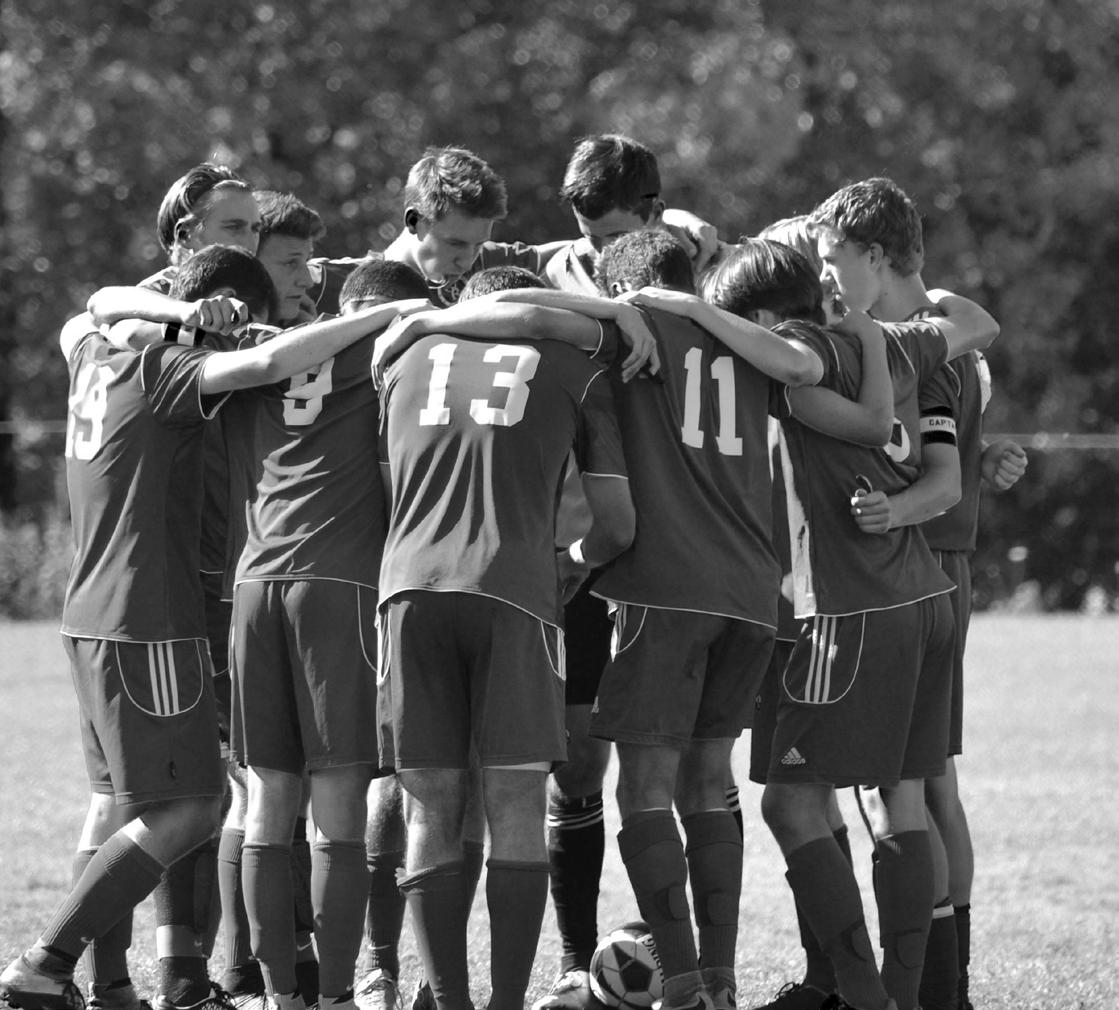
When training it’s really important to build back muscle memory that was lost over the off season. “Preseason is the hardest because we have to get back in the groove of it all with added 90 degree weather,” says Julia Williams (17’), ORHS field hockey player. The fall season could arguably be one of the hardest given the heat and amount of time off from a previous season. Staying focused and determined is the key to success during preseason training. “It’s more organized and less rushed (fall training),” says Samuel Davies (18’), ORHS soccer and lacrosse player. “There are so many opportunities to train during the summer, I find that I come into the fall season much more prepared than I do going into the spring season.”
Summer can be a make or break point for athletes and pay off in their season. Being mentally tough, and physically strong when training for the regular season is what will help teams improve the most. We are at the point where teams will start to notice how rewarding a good preseason can be as we approach playoffs and state competitions. Soon enough Oyster River will be taking home the big win.
-Betsy Larson Social Media Manager
The Oyster River High School girls soccer program started their summer training with
coaches had departed to pursue other ventures and their positions were there
seasons to spend more time with her growing business, Quest Martial Arts
the JV coach, left to coach varsity soccer at Ports mouth High School. However, both spots were filled just in time. The varsity spot was taken by Steve Pettit and the JV spot by Derek Cangello. “At first I was nervous about the new coaches be cause obviously it’s my senior year and I want it to be successful,” said Jewelia Durant (‘16), “but honestly from the first day we met him I could tell that he was really invested in this program.”
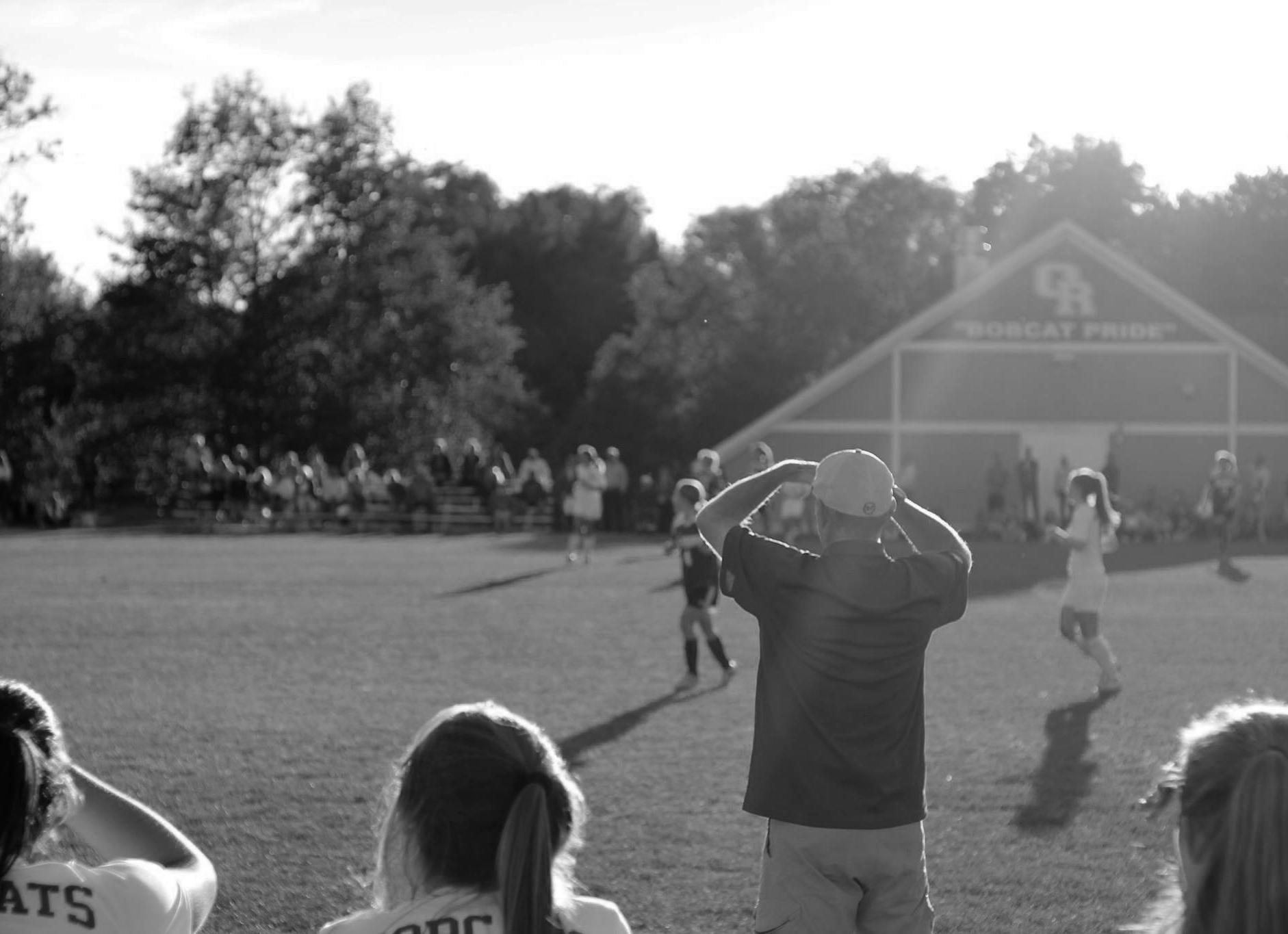
Steve Pettit, who has coached both Oyster River Youth Association and Seacoast United, is very familiar with the game. “I would say we’re look ing to create more opportunities to score than we have in the past,” said Pettit. “A number of things change any time a new coach comes into a program, whether intended or not,” said Pet tit. One of the major changes in the girls soccer program is that there is a flexible roster, mean ing that there is no set roster for the season. “The new roster for every game is setup to include 1-3 JV/swing players. Some of those players are dif ferent from game to game depending on who we play and what we need in terms of position help,” said varsity soccer player Claire Genes (‘17). Pet tit’s approach may be unlike most sports at the school, but he has a technique that seems to be working. “The team rosters change for a number
of reasons, including injuries, team shape changes, player improvement, etc. Player development is neither static nor linear, so the roster must be able to accommodate those changes,” said Pettit.
The new roster changes don’t work for everyone, and in some cases can make it difficult to be mentally fo cused. “It is a little stressful how the rosters change every game, because you never know exactly who you will be playing with, or if you are on the roster which makes it harder to prepare,” said Devan Mcclain (‘19). For others it can work in their favor.
“Regarding the rosters, yes it is an adjustment, but I think it gives the developing players a chance to be introduced to a higher level of play and can be motivational,” said Jessie Mulligan (‘17), a swing player. The Bobcats are 15-1 this season and Pet tit’s style is making an impact. Last year the Bobcats finished the season at 11-7 and lost in the second round of the playoffs, which shows that, so far, the new style is paying off.
-Owen Kurtiak“Even though I can’t play, that doesn’t stop me from practicing with the team.” Explains an optimistic Cam Schiavo (‘19) in regards to his role on the Oyster River High School field hockey team.
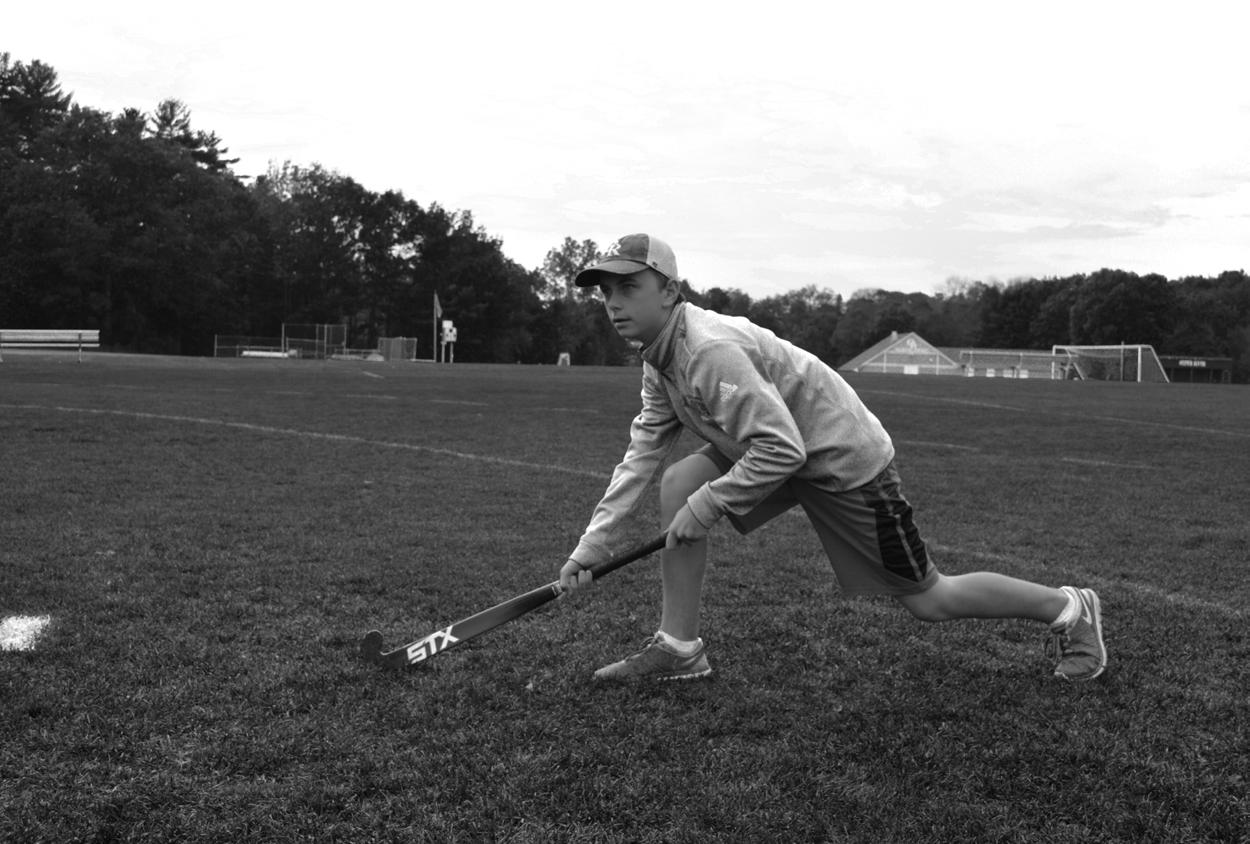

As of now, the NHIAA [New Hampshire Interscho lastic Athletic Association] doesn’t allow men to partic ipate in girls Varsity High School teams in the state of New Hampshire, even if there isn’t a boys team pro vided. Schiavo takes part in managing and preparing for games with the team, but can not play in this fall 2015 season. With help from his family, ORHS school ad ministrators, and his fellow teammates, Schiavo is in the process of contacting the NHIAA in hopes to play in the upcoming seasons.
The NHIAA strictly follows the logistics and regulations of the law Title IX. This law was introduced to eliminate discrimination back in 1972, stating, “No person in the United States shall, on the basis of sex, be excluded from participation in, be denied the bene fits of, or be subjected to discrimination under any education pro gram or activity receiving Federal financial assistance.” This was initially introduced to provide women with a law that promoted equality in highschool and college level sports. Schiavo believes to day the Title IX contradicts itself, given its initial purpose of equal ity. Schiavo explains, “I think that the reason Title IX was created has done its job in the past [in terms of women’s rights], but now needs to be modified for modern times”.
Schiavo had never thought of playing the sport until there was a shortage of field hockey players in his eighth grade year at Bar rington Middle School. Schiavo explains, “I had heard that they weren’t big enough to field a team so I decided to play to allow them to play. I was 100% allowed and even encouraged to play in mid dle school”. Schiavo was then surprised to hear that the NHIAA wouldn’t allow him to play, stating, “My family had looked into the rule book many times and it rarely to never says “women’s field hockey”, or specifies that it is a female-only sport.”
Phil Schiavo, father of Cam, explains the process. “About 3 weeks before the preseason workouts were to begin we found out that the NHIAA would not allow males to play field hockey. At that point we contacted our attorney to see what our options are and what could be done to look at this in a legal way. The at torney then sent an official re quest to the NHIAA on Cam’s behalf.”
ORHS field hockey play er Alaina Todd (‘16) wasn’t surprised by her fellow team mate not being able to play in games. Todd explains, “My initial thought was that the NHIAA most likely wouldn’t allow Cam to play, and I thought that other teams
would have a problem with it.” Todd is conflicted with the matter, explaining, “I would love to have Cam play; I think he would really bene fit this team… Although, the problem is in the future if the numbers wouldn’t be bal anced and more males would play than females. If the team was co-ed, the team and the game itself would change drastically.”
ORHS JV coach Anne Gold ing believes, “If there is no men’s team I don’t see any reason why they can’t partic ipate at a JV level at least. I get that overall adding men to a sport currently dominated by women would change the dynamic, but we have to come up with some way for men to be able to participate if we (as a country and culture) want to grow the sport the way coaches should.”
With the discussion of what this all would mean for the field hockey team in the future in full swing, Schiavo has taken action to contact the NHIAA. He explains, “Mr. Parker the athletic director and Mr. Allen the school principal both submitted a letter to peti tion [to the NHIAA], then my father and I sent in a letter ourselves.” Cory Parker, athletic director of ORHS explains the dilemma sur rounding Title IX. “We reached out to the NHIAA for clarification. We looked into the Office of Civil Rights, which could argue that because Cam is a boy and he can not play because of that, he is being treated unfairly. Although, Title IX is a more federal law, so it usually triumphs in court cases.”
Schiavo’s father explains the current status of the situation saying, “The NHIAA has responded that currently due to Title IX they are not going to change their stance on allowing males to play field hockey.”
Parker further explains, “Due to this case with Cam, along with another case in Dover, NH surrounding a boy wanting to play an all-girls’ sport, the issue is going to be discussed at the Executive Council [of the NHIAA] level. Although as of now, unfortunately I don’t believe Cam will be able to play next season. Beyond that, I don’t know what will be the case in years to come.”
Along with participation from ORHS administration, Schiavo has asked for verbal support from his team mates, suggesting that the players, along with the coaches, submit their own letters to the NHIAA, hoping to sway the board and allow him to take part in the sport that he is currently prohibited to play.
-Jessie Stelter Layout Editor“I think that the reason Title IX was cre ated has done its job in the past [in terms of women’s rights], but now needs to be modified for modern times”.








If I should die, think only this of me: That there’s some corner of a foreign field That is for ever England. There shall be In that rich earth a richer dust concealed; A dust whom England bore, shaped, made aware, Gave, once, her flowers to love, her ways to roam, A body of England’s, breathing English air, Washed by the rivers, blest by suns of home.
And think, this heart, all evil shed away, A pulse in the eternal mind, no less Gives somewhere back the thoughts by England given; Her sights and sounds; dreams happy as her day; And laughter, learnt of friends; and gentleness, In hearts at peace, under an English heaven.
“The Soldier” - Rupert Brooke
Mouth of the River is creating a digital memorial for Martin Brewer, including photos, audio, and stories.
If you have any material or stories you would like to share, please submit them to mornewspaper@gmail.com


